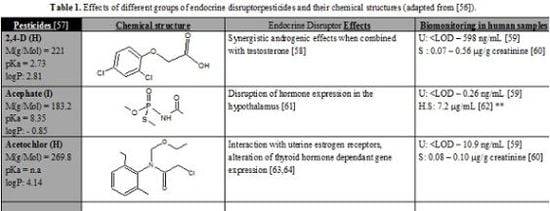Effect of Endocrine Disruptor Pesticides: A Review
Abstract
:1. Introduction
2. Effects of Endocrine Disruptor Pesticides
3. Biomonitoring for Human Exposure Assessment
4. Discussion and Perspectives
Abbreviations:
| ADI: | Acceptable Daily Intake; |
| AhR: | ArylHydrocarbon Receptor; |
| AR: | Androgen Receptor; |
| CA: | Concentration Addition; |
| CAR: | Constitutive Androstane Receptor; |
| EDC: | Endocrine Disruptor Chemical; |
| ER: | Estrogen Receptor; |
| ERR: | Estrogen Related Receptor; |
| HCH: | Hexachlorocyclohexane; |
| IA: | Independent Action; |
| LOD: | Limit of Detection; |
| PCB: | PolyChloroBiphenyl; |
| PXR: | Pregnane X Receptor; |
| WHO: | World Health Organisation |
References
- Mellanby, K. The DDT Story; British Crop Protection Council: Hampshire, UK, 1992. [Google Scholar]
- Briggs, J. Green revolution. Int Encycl Hum Geogr 2009, 634–638. [Google Scholar]
- Cooper, J; Dobson, H. The benefits of pesticides to mankind and the environment. Crop Prot 2007, 26, 1337–1348. [Google Scholar] [Green Version]
- Carson, R. Silent Spring; Houghton Mifflin: Boston, MA, USA, 1962. [Google Scholar]
- Kolpin, DW; Thurman, EM; Linhart, SM. Finding minimal herbicide concentrations in ground water? Try looking for their degradates. Sci. Total Environ 2000, 248, 115–122. [Google Scholar] [Green Version]
- WHO. Our Planet, Our Health; Report of the WHO Commission on Health and Environment; WHO: Geneva, Switzerland, 1992. [Google Scholar]
- Vinggaard, AM; Hnida, C; Breinholt, V; Larsen, JC. Screening of selected pesticides for inhibition of CYP19 aromatase activity in vitro. Toxicol. In Vitro 2000, 14, 227–234. [Google Scholar] [Green Version]
- Andersen, HR; Cook, SJ; Waldbillig, D. Effects of currently used pesticides in assays for estrogenicity, androgenicity, and aromatase activity in vitro. Toxicol. Appl. Pharmacol 2002, 179, 1–12. [Google Scholar] [Green Version]
- Kojima, H; Katsura, E; Takeuchi, S; Niiyama, K; Kobayashi, K. Screening for estrogen and androgen receptor activities in 200 pesticides by in vitro reporter gene assays using Chinese hamster ovary cells. Environ. Health Perspect 2004, 112, 524–531. [Google Scholar] [Green Version]
- Lemaire, G; Mnif, W; Mauvais, P; Balaguer, P; Rahmani, R. Activation of alpha- and beta- estrogen receptors by persistent pesticides in reporter cell lines. Life Sci 2006, 79, 1160–1169. [Google Scholar] [Green Version]
- Lemaire, G; Mnif, W; Pascussi, JM; Pillon, A; Rabenoelina, F; Fenet, H; Gomez, E; Casellas, C; Nicolas, JC; Cavailles, V; et al. Identification of new human PXR ligands among pesticides using a stable reporter cell system. Toxicol. Sci 2006, 91, 501–509. [Google Scholar] [Green Version]
- Tabb, MM; Blumberg, B. New modes of action for endocrine-disrupting chemicals. Mol. Endocrinol 2006, 20, 475–482. [Google Scholar] [Green Version]
- Cocco, P. On the rumors about the silent spring. Review of the scientific evidence linking occupational and environmental pesticide exposure to endocrine disruption health effects. Cad. Saúde Pública 2002, 18, 379–402. [Google Scholar] [Green Version]
- Akhtar, N; Kayani, SA; Ahmad, MM; Shahab, M. Insecticide-induced changes in secretory activity of the thyroid gland in rats. J. Appl. Toxicol 1996, 16, 397–400. [Google Scholar] [Green Version]
- Leghait, J; Gayrard, V; Picard-Hagen, N; Camp, M; Perdu, E; Toutain, PL; Viguié, C. Fipronil-induced disruption of thyroid function in rats is mediated by increased total and free thyroxine clearances concomitantly to increased activity of hepatic enzymes. Toxicology 2009, 255, 38–44. [Google Scholar] [Green Version]
- Sugiyama, S; Shimada, N; Miyoshi, H; Yamauchi, K. Detection of thyroid systemdisrupting chemicals using in vitro and in vivo screening assays in Xenopus laevis. Toxicol. Sci 2005, 88, 367–374. [Google Scholar] [Green Version]
- Bryan, GW; Gibbs, PE; Hummerstone, LG; Burt, GR. The decline of the gastropod Nucella lapillus around south-west England: Evidence for the effect of tributyltin from antifouling paints. J. Mar. Biol. Assoc. UK 1986, 66, 611–640. [Google Scholar] [Green Version]
- Short, JW; Rice, SD; Brodersen, CC; Stickle, WB. Occurrence of tri-N-butyltin caused imposex in the north pacific marine snail Nucella limaz in Auke Bay; Alaska. Mar. Biol 1989, 102, 291–297. [Google Scholar] [Green Version]
- Ellis, DV; Pattisina, LA. Widerspread neogastropod imposex; a biological indicator of TBT contamination. Mar. Pollut. Bull 1990, 21, 248–253. [Google Scholar] [Green Version]
- Heidrich, DD; Steckelbroeck, S; Klingmuller, D. Inhibition of human cytochrome P450 aromatase activity by butyltins. Steroids 2001, 66, 763–769. [Google Scholar] [Green Version]
- Gooding, MP; Wilson, VS; Folmar, LC; Marcovich, DT; LeBlanc, GA. The biocide tributyltin reduces the accumulation of testosterone as fatty acid esters in the mud snail (Ilyanassa obsoleta). Environ. Health Perspect 2003, 111, 426–230. [Google Scholar] [Green Version]
- Bishop, CA; Brooks, RJ; Carey, JH; Norstrom, PNRJ; Lean, DRS. The case for a cause-effect linkage between environmental contamination and development in egg of the common snapping turtle (chelydra serpentina) from Ontario. Canada. J. Toxicol. Environ. Health 1991, 33, 521–547. [Google Scholar] [Green Version]
- Bishop, CA; Lean, DRS; Brooks, RJ; Carey, JH; Norstrom, PNRJ. Chlorinated hydrocarbons in early life stages of the common snappling turtle (chelydra serpentina serpentina) from a coastal wetland on lake Ontario. Canada. Environ. Toxicol. Chem 1995, 14, 421–426. [Google Scholar] [Green Version]
- Guillette, LJ; Gross, TS; Masson, GR; Matter, JM; Percival, HF; Woodward, AR. Developmental abnormalities of the gonad and abnormal sex hormone concentrations in juvenile alligators from contaminated and control lakes in Florida. Environ. Health Perspect 1995, 102, 680–688. [Google Scholar] [Green Version]
- Guillette, LJ; Pickford, DB; Crain, DA; Rooney, AA; Percival, HF. Reduction in penis size and plasma testosterone concentrations in juvenile alligators living in a contaminated environnement. Gen. Comp. Endocrinol 1996, 101, 32–42. [Google Scholar] [Green Version]
- Guillette, LJ; Brock, JW; Rooney, AA; Woodward, AR. Serum concentration of various environmental contaminants and their relationship to sex steroid concentration and phallus size in juvenile American alligators. Arch. Environ. Contam. Toxicol 1999, 36, 447–455. [Google Scholar] [Green Version]
- Crain, DA; Guillette, LJ; Pickford, DB; Rooney, A. Alterations in steroidogenesis in alligators (alligator mississippiensis) exposed naturally and experimentally to environmental contaminants. Environ. Health Perspect 1997, 105, 528–533. [Google Scholar] [Green Version]
- Munkittrick, KR; Port, CB; Van Der Kraak, GJ; Smith, IR; Rokosh, DA. Impact of bleach kraft mill effluent on population characteristics; liver MFO activity; and serum steroid levels of a Lake Superior white sucker (Catostomus commersoni). Can. J. Fish Aquat. Sci 1991, 48, 1371–1380. [Google Scholar] [Green Version]
- Purdom, CE; Hardiman, PA; Bye, VJ; Eno, NC; Tyler, CR; Sumpter, JP. Estrogenic effects of effluents from sewage treatment works. Chem. Ecol 1994, 8, 275–285. [Google Scholar] [Green Version]
- Fry, DM; Toone, CK. DDT-induced feminization of gull embryos. Science 1981, 213, 922–924. [Google Scholar] [Green Version]
- Fry, DM; Toone, CK; Speich, SM; Peard, RJ. Sex ratio skew and breeding patterns of gulls, demographic and toxicological considerations. Stud. Avian Biol 1987, 10, 26–43. [Google Scholar] [Green Version]
- Crisp, TM; Clegg, ED; Cooper, RL; Wood, WP; Anderson, DG; Baetcke, KP; Hoffmann, JL; Morrow, MS; Rodier, DJ; Schaeffer, JE; et al. Environmental endocrine disruption: An effects assessment and analysis [Review]. Environ. Health Perspect 1998, 106, 11–56. [Google Scholar] [Green Version]
- Tyler, CR; Jobling, S; Sumpter, JP. Endocrine disruption in wildlife, a critical review of the evidence. Crit. Rev. Toxicol 1998, 28, 319–361. [Google Scholar] [Green Version]
- Vos, JG; Dybing, E; Greim, HA; Ladefoged, O; Lambré, C; Tarazona, JV; Brandt, I; Vethaak, AD. Health effects of endocrine-disrupting chemicals on wildlife; with special reference to the European sitation. Crit. Rev. Toxicol 2000, 30, 71–133. [Google Scholar] [Green Version]
- Reijnders, PJ. Reproductive failure in common seals feeding on fish from polluted coastal waters. Nature 1986, 324, 456–457. [Google Scholar] [Green Version]
- Norstrom, RJ; Muir, DC. Chlorinated hydrocarbon contaminants in arctic marine mammals. Sci. Total Environ 1994, 154, 107–128. [Google Scholar] [Green Version]
- Facemire, CF; Gross, TS; Guillette, LJ. Reproductive impairment in the Florida panther: Nature or nuture? Environ. Health Perspect 1995, 103, 79–86. [Google Scholar] [Green Version]
- Oskam, IC; Ropstad, E; Dahl, E; Lie, E; Derocher, AE; Wiig, O; Larsen, S; Wiger, R; Skaare, JU. Organochlorines affect the major androgenic hormone; testosterone; in male polar bears (Ursus maritimus) at Svalbard. J. Toxicol. Environ. Health A 2003, 66, 2119–2139. [Google Scholar] [Green Version]
- Mnif, W; Pillon, A; Balaguer, P; Bartegi, A. Endocrine xenoestrogenics disrupters, molecular mechanisms and detection methods. Therapie 2007, 62, 369–386. [Google Scholar] [Green Version]
- Palma, P; Palma, VL; Matos, C; Fernandes, RM; Bohn, A; Soares, AMVM; Barbosa, IR. Effects of atrazine and endosulfan sulphate on the ecdysteroid system of Daphnia magna. Chemosphere 2009, 74, 676–681. [Google Scholar] [Green Version]
- Palma, P; Palma, VL; Matos, C; Fernandes, RM; Bohn, A; Soares, AMVM; Barbosa, IR. Assessment of the pesticides atrazine; endosulfan sulphate and chlorpyrifos for juvenoid-related endocrine activity using Daphnia magna. Chemosphere 2009, 76, 335–340. [Google Scholar] [Green Version]
- Wilson, VS; Lambright, CR; Furr, JR; Howdeshell, KL; Gray, LE, Jr. The Herbicide Linuron Reduces Testosterone Production from the Fetal Rat Testis During Both In Utero and In Vitro Exposures. Toxicol. Lett 2009, 186, 73–77. [Google Scholar] [Green Version]
- Birnbaum, LS; Fenton, SE. Cancer and developmental exposure to endocrine disruptors. Environ. Health Perspect 2003, 111, 389–394. [Google Scholar] [Green Version]
- Goldman, L; Falk, H; Landrigan, PJ; Balk, SJ; Reigart, R; Etzel, RA. Environmental pediatrics and its impact on government health policy. Pediatrics 2004, 113, 1146–1157. [Google Scholar] [Green Version]
- Sharpe, RRM. Pathways of endocrine disruption during male sexual differentiation and masculinisation. Best. Pract. Res. Clin. Endocrinol. Metab 2006, 20, 91–110. [Google Scholar] [Green Version]
- Sultan, C; Balaguer, P; Terouanne, B; Georget, V; Paris, F; Jeandel, C; Lumbroso, S; Nicolas, J. Environmental xenoestrogens; antiandrogens and disorders of male sexual differentiation. Mol. Cell. Endocrinol 2001, 178, 99–105. [Google Scholar] [Green Version]
- Skakkebaek, NN. Endocrine disrupters and testicular dysgenesis syndrome. Horm. Res 2002, 57, 43. [Google Scholar] [Green Version]
- Hardell, L; Bavel, B; Lindström, G; Eriksson, M; Carlberg, M. In utero exposure to persistent organic pollutants in relation to testicular cancer risk. Int. J. Androl 2006, 29, 228–234. [Google Scholar] [Green Version]
- Anderson, H; Wolff, MS. Environmental contaminants in human milk. J. Expo. Anal. Environ. Epidemiol 2000, 10, 755–760. [Google Scholar] [Green Version]
- Waliszewski, S; Aguirre, AA; Infanzón, RM; Siliceo, J. Carry-over of persistent organochlorine pesticides through placenta to fetus. Salud. Publica Mex 2000, 42, 384–390. [Google Scholar] [Green Version]
- Przyrembel, H; Heinrich-Hirsch, B; Vieth, B. Exposition to and health effects of residues in human milk. Adv. Exp. Med. Biol 2000, 478, 307–325. [Google Scholar] [Green Version]
- Jacobson, JL; Jacobson, SW. Intellectual impairment in children exposed to polychlorinated biphenyls in utero. N. Engl. J. Med 1996, 335, 783–789. [Google Scholar] [Green Version]
- Eskenazi, B; Marks, AR; Bradman, A; Fenster, L; Johnson, C; Barr, DB. In utero exposure to dichlorodiphenyltrichloroethane (DDT) and dichlorodiphenyldichloroethylene (DDE) and neurodevelopment among young Mexican American children. Pediatrics 2006, 118, 233–241. [Google Scholar] [Green Version]
- Ribas-Fito, N; Cardo, E; Sala, M; Eulalia de Muga, M; Mazon, C; Verdu, A; Kogevinas, M; Grimalt, JO; Sunyer, J. Breastfeeding exposure to organochlorine compounds and neurodevelopment in infants. Pediatrics 2003, 111, 580–585. [Google Scholar] [Green Version]
- Beard, J. Australian rural health research collaboration. DDT and human health. Sci. Total Environ 2006, 355, 78–89. [Google Scholar] [Green Version]
- Xiang, H; Nuckols, JR; Stallones, L. A geographic information assessment of birth weight and crop production patterns around mother’s residence. Environ. Res. A 2000, 82, 160–167. [Google Scholar] [Green Version]
- Bell, EM; Hertz-Picciotto, I; Beaumont, JJ. A case-control study of pesticides and fetal death due to congenital anomalies. Epidemiology 2001, 12, 148–156. [Google Scholar] [Green Version]
- Reynolds, P; Von Behren, J; Gunier, RB; Goldberg, DE; Hertz, A; Harnly, ME. Childhood cancer and agricultural pesticide use, an ecologic study in California. Environ. Health Perspect 2002, 110, 319–324. [Google Scholar] [Green Version]
- Kristensen, P; Irgens, LM; Andersen, A; Bye, AS; Sundheim, L. Birth defects among offspring of Norwegian farmers; 1967–1991. Epidemiology 1997, 8, 537–544. [Google Scholar] [Green Version]
- Carbone, P; Giordano, F; Nori, F; Mantovani, A; Taruscio, D; Lauria, L; Figà-Talamanca, I. Cryptorchidism and hypospadias in the Sicilian district of Ragusa and the use of pesticides. Reprod. Toxicol 2006, 22, 8–12. [Google Scholar] [Green Version]
- Weidner, IS; Moller, H; Jensen, TK; Skakkebæk, NE. Cryptorchidism and hypospadias in sons of gardeners and farmers. Environ. Health Perspect 1998, 106, 793–796. [Google Scholar] [Green Version]
- Skakkebæk, NE; Rajpert-De Meyts, E; Main, KM. Testicular dysgenesis syndrome, an increasingly common developmental disorder with environmental aspects. Hum. Reprod 2001, 16, 972–978. [Google Scholar] [Green Version]
- Damgaard, IN; Skakkebaek, NE; Toppari, J; Virtanen, HE; Shen, H; Schramm, KW; Petersen, JH; Jensen, TK; Main, KM. Persistent pesticides in human breast milk and cryptorchidism. Environ. Health Perspect 2006, 114, 1133–1138. [Google Scholar] [Green Version]
- Roeleveld, N; Bretveld, R. The impact of pesticides on male fertility. Curr. Opin. Obstet. Gynecol 2008, 20, 229–233. [Google Scholar] [Green Version]
- McKinlay, R; Plant, JA; Bell, JNB; Voulvoulis, N. Endocrine disrupting pesticides, Implications for risk assessment. Environ. Int 2008, 34, 168–183. [Google Scholar] [Green Version]
- PPDB: Pesticide Properties DataBase. University of Hertfordshire. Available online: http://sitem.herts.ac.uk/aeru/footprint/fr/index.htm (accessed on 12 March 2011).
- Kim, DO; Lee, SK; Jeon, TW; Jin, CH; Hyun, SH; Kim, EJ; Moon, GI; Kim, JA; Lee, ES; Lee, BM; et al. Role of metabolism in parathion-induced hepatotoxicity and immunotoxicity. J. Toxicol. Environ. Health A 2005, 68, 2187–2205. [Google Scholar] [Green Version]
- Panuwet, P; Prapamontol, T; Chantara, S; Thavornyuthikarn, P; Montesano, MA; Whitehead, R, Jr; Barr, DB. Concentrations of urinary pesticide metabolites in small-scale farmers in Chiang Mai Province; Thailand. Sci. Total Environ 2008, 407, 655–668. [Google Scholar] [Green Version]
- Swan, SH; Kruse, RL; Liu, F; Barr, DB; Drobnis, EZ; Redmon, JB; Wang, C; Brazil, C; Overstreet, JW; Study for Future Families Research Group. Semen quality in relation to biomarkers of pesticide exposure. Environ. Health Perspect 2003, 111, 1478–1484. [Google Scholar] [Green Version]
- Singh, AK. Acute effects of acephate and methamidophos and interleukin-1 on corticotropin-releasing factor (CRF) synthesis in and release from the hypothalamus in vitro. Comp. Biochem. Physiol. C Toxicol. Pharmacol 2002, 132, 9–24. [Google Scholar] [Green Version]
- Inoue, S; Saito, T; Mase, H; Suzuki, Y; Takazawa, K; Yamamoto, I; Inokuchi, S. Rapid simultaneous determination for organophosphorus pesticides in human serum by LC–MS. J. Pharm. Biomed. Anal 2007, 44, 258–264. [Google Scholar] [Green Version]
- Rollerová, EE. Interaction of acetochlor with estrogen receptor in the rat uterus. Acetochlor—possible endocrinemodulator? Gen. Physiol. Biophys 2000, 19, 73–84. [Google Scholar] [Green Version]
- Crump, D; Werry, K; Veldhoen, N; Van Aggelen, G; Helbing, CC. Exposure to the herbicide acetochlor alters thyroid hormone-dependent gene expression and metamorphosis in Xenopus laevis. Environ Health Perspect 2002, 110, 1199–205. [Google Scholar] [Green Version]
- Mikamo, E; Harada, S; Nishikawa, J; Nishihara, T. Endocrine disruptors induce cytochrome P450 by affecting transcriptional regulation via pregnane X receptor. Toxicol Appl. Pharmacol 2003, 193, 66–72. [Google Scholar] [Green Version]
- Klotz, D; Arnold, SF; McLachlan, JA. Inhibition of 17 beta-estradiol and progesterone activity in human breast and endometrial cancer cells by carbamate insecticides. Life Sci 1997, 60, 1467–1475. [Google Scholar] [Green Version]
- Lemaire, G; Terouanne, B; Mauvais, P; Michel, S; Rahmani, R. Effect of organochlorine pesticides on human androgen receptor activation in vitro. Toxicol. Appl. Pharmacol 2004, 196, 235–246. [Google Scholar] [Green Version]
- Cruz, S; Lino, C; Silveira, MI. Evaluation of organochlorine pesticide residues in human serum from an urban and two rural populations in Portugal. Sci. Total Environ 2003, 317, 23–35. [Google Scholar] [Green Version]
- Botella, B; Crespo, J; Rivas, A; Cerrillo, I; Olea-Serrano, MF; Olea, N. Exposure of women to organochlorine pesticides in Southern Spain. Environ. Res 2004, 96, 34–40. [Google Scholar] [Green Version]
- Nasir, K; Bilto, YY; Al-Shuraiki, Y. Residues of chlorinated hydrocarbon insecticides in human milk of Jordanian women. Environ. Pollut 1998, 99, 141–148. [Google Scholar] [Green Version]
- Cooper, R; Stoker, TE; Tyrey, L; Goldman, JM; McElroy, WK. Atrazine disrupts the hypothalamic control of pituitary-ovarian function. Toxicol. Sci 2000, 53, 297–307. [Google Scholar] [Green Version]
- Sanderson, JT; Seinen, W; Giesy, JP; van den Berg, M. 2-Chloro-s-triazine herbicides induce aromatase (CYP19) activity in H295R human adrenocortical carcinoma cells, a novel mechanism for estrogenicity? Toxicol. Sci 2000, 54, 121–127. [Google Scholar] [Green Version]
- Hayes, T; Tsui, M; Hoang, A; Haeffele, C; Vonk, A. Atrazine-induced hermaphroditism at 0.1 ppb in American leopard frogs (Rana pipiens); laboratory and field evidence. Environ. Health Perspect 2003, 111, 568–575. [Google Scholar] [Green Version]
- Thibaut, R; Porte, C. Effects of endocrine disrupters on sex steroid synthesis and metabolism pathways in fish. J. Steroid Biochem. Mol. Biol 2004, 92, 485–494. [Google Scholar] [Green Version]
- Curwin, BD; Hein, MJ; Sanderson, WT; Striley, C; Heederik, D; Kromhout, H; Reynolds, SJ; Alavanja, MC. Urinary Pesticide Concentrations Among Children; Mothers and Fathers Living in Farm and Non-Farm Households in Iowa. Ann. Occup. Hyg 2007, 51, 53–65. [Google Scholar] [Green Version]
- Barr, DB; Barr, JR; Maggio, VL; Whitehead, RD, Jr; Sadowski, MA; Whyatt, RM; Needham, LL. A multi-analyte method for the quantification of contemporary pesticides in human serum and plasma using high-resolution mass spectrometry. J. Chromatogr. B Analyt. Technol. Biomed. Life Sci 2002, 778, 99–111. [Google Scholar] [Green Version]
- Morinaga, H; Yanase, T; Nomura, M; Okabe, T; Goto, K; Harada, N; Nawata, H. A benzimidazole fungicide; benomyl; and its metabolite; carbendazim; induce aromatase activity in a human ovarian granulose-like tumor cell line (KGN). Endocrinology 2004, 145, 1860–1869. [Google Scholar] [Green Version]
- Kim, IY; Shin, JH; Kim, HS; Lee, SJ; Kang, IH; Kim, TS; Moon, HJ; Choi, KS; Moon, A; Han, SY. Assessing estrogenic activity of pyrethroid insecticides using in vitro combination assays. J. Reprod. Dev 2004, 50, 245–255. [Google Scholar] [Green Version]
- Ostrea, EM, Jr; Bielawski, DM; Posecion, NC, Jr; Corrion, M; Villanueva-Uy, E; Bernardo, RC; Jin, Y; Janisse, JJ; Ager, JW. Combined analysis of prenatal (maternal hair and blood) and neonatal (infant hair; cord blood and meconium) matrices to detect fetal exposure to environmental pesticides. Environ. Res 2009, 10, 116–122. [Google Scholar] [Green Version]
- Trosken, EE; Scholz, K; Lutz, RW; Volkel, W; Zarn, JA; Lutz, WK. Comparative assessment of the inhibition of recombinant human CYP19 (aromatase) by azoles used in agriculture and as drugs for humans. Endocr. Res 2004, 30, 387–394. [Google Scholar] [Green Version]
- Okubo, T; Yokoyama, Y; Kano, K; Soya, Y; Kano, I. Estimation of estrogenic and antiestrogenic activities of selected pesticides by MCF-7 cell proliferation assay. Arch. Environ. Contam. Toxicol 2004, 46, 445–453. [Google Scholar] [Green Version]
- Goad, R; Goad, J; Atieh, B; Gupta, R. Carbofuran-Induced endocrine disruption in adult male rats. Toxicol. Mech. Methods 2004, 14, 233–239. [Google Scholar] [Green Version]
- Barr, DB; Ananth, CV; Yan, X; Lashley, S; Smulian, JC; Ledoux, TA; Hore, P; Robson, MG. Pesticide concentrations in maternal and umbilical cord sera and their relation to birth outcomes in a population of pregnant women and newborns in New Jersey. Sci. Total Environ 2010, 408, 790–795. [Google Scholar] [Green Version]
- Tessier, D; Matsumura, F. Increased ErbB-2 tyrosine kinase activity; MAPK phosphorylation; and cell proliferation in the prostate cancer cell line LNCaP following treatment by select pesticides. Toxicol. Sci 2001, 60, 38–43. [Google Scholar] [Green Version]
- Röllin, HB; Sandanger, TM; Hansen, L; Channa, K; Odland, JØ. Concentration of selected persistent organic pollutants in blood from delivering women in South Africa. Sci. Total Environ 2009, 408, 146–152. [Google Scholar] [Green Version]
- Kang, JH; Park, H; Chang, YS; Choi, JW. Distribution of organochlorine pesticides (OCPs) and polychlorinated biphenyls (PCBs) in human serum from urban areas in Korea. Chemosphere 2008, 73, 1625–1631. [Google Scholar] [Green Version]
- Schinas, V; Leotsinidis, M; Alexopoulos, A; Tsapanos, V; Kondakis, XG. Organochlorine pesticide residues in human breast milk from southwest Greece, associations with weekly food consumption patterns of mothers. Arch. Environ. Health 2000, 55, 411–417. [Google Scholar] [Green Version]
- Tanabe, S; Kunisue, T. Persistent organic pollutants in human breast milk from Asian countries. Environ. Pollut 2007, 146, 400–413. [Google Scholar] [Green Version]
- Polder, A; Thomsen, C; Lindström, G; Løken, KB; Skaare, JU. Levels and temporal trends of chlorinated pesticides; polychlorinated biphenyls and brominated flame retardants in individual human breast milk samples from Northern and Southern Norway. Chemosphere 2008, 73, 14–23. [Google Scholar] [Green Version]
- Devanathan, G; Subramanian, A; Someya, M; Sudaryanto, A; Isobe, T; Takahashi, S; Chakraborty, P; Tanabe, S. Persistent organochlorines in human breast milk from major metropolitan cities in India. Environ. Pollut 2009, 157, 148–154. [Google Scholar] [Green Version]
- Jarrell, JF; Villeneuve, D; Franklin, C; Bartlett, S; Wrixon, W; Kohut, J; Zouves, CG. Contamination of human ovariam follicular fluid and serum by chlorinated organic compounds in three Canadian cities. Can. Med. Assoc. J 1993, 148, 1321–1327. [Google Scholar] [Green Version]
- Tapiero, HT; Nguyen, BG; Tew, KD. Estrogens and environmental estrogens. Biomed. Pharmacother 2002, 56, 36–44. [Google Scholar] [Green Version]
- Fang, H; Tong, W; Branham, WS; Moland, CL; Dial, SL; Hong, H; Xie, Q; Perkins, R; Owens, W; Sheehan, DM. Study of 202 natural; synthetic; and environmental chemicals for binding to the androgen receptor. Chem. Res. Toxicol 2003, 16, 1338–1358. [Google Scholar] [Green Version]
- Vinggaard, A; Breinholt, V; Larsen, JC. Screening of selected pesticides for oestrogen receptor activation in vitro. Food Addit. Contam 1999, 16, 533–542. [Google Scholar] [Green Version]
- Kang, HG; Jeong, SH; Cho, JH; Kim, DG; Park, JM; Cho, MH. Chlropyrifos-methyl shows anti-androgenic activity without estrogenic activity in rats. Toxicology 2004, 199, 219–230. [Google Scholar] [Green Version]
- Chen, H; Xiao, J; Hu, G; Zhou, J; Xiao, H; Wang, X. Estrogenicity of organophosphorus and pyrethroid pesticides. J. Toxicol. Environ. Health A 2002, 65, 1419–1435. [Google Scholar] [Green Version]
- McCarthy, AR; Thomson, BM; Shaw, IC; Abella, AD. Estrogenicity of pyrethroid insecticide metabolites. J. Environ. Monit 2006, 8, 197–202. [Google Scholar] [Green Version]
- Hardt, J; Angerer, J. Biological monitoring of workers after the application of insecticidal pyrethroids. Int. Arch. Occup. Environ. Health 2003, 76, 492–498. [Google Scholar] [Green Version]
- Tapiero, HT; Nguyen, BG; Tew, KD. Estrogens and environmental estrogens. Biomed. Pharmacother 2002, 56, 36–44. [Google Scholar] [Green Version]
- Bulayeva, NN; Watson, CS. Xenoestrogen-induced ERK-1 and ERK-2 activation via multiple membrane-initiated signaling pathways. Environ. Health Perspect 2004, 112, 1481–1487. [Google Scholar] [Green Version]
- Qu, W; Suri, RPS; Bi, X; Sheng, G; Fu, J. Exposure of young mothers and newborns to organochlorine pesticides (OCPs) in Guangzhou; China. Sci. Total Environ 2010, 408, 3133–3138. [Google Scholar] [Green Version]
- Fujii, Y; Haraguchi, K; Harada, KH; Hitomi, T; Inoue, K; Itoh, Y; Watanabe, T; Takenaka, K; Uehara, S; Yang, HR; et al. Detection of dicofol and related pesticides in human breast milk from China; Korea and Japan. Chemosphere 2011, 82, 25–31. [Google Scholar] [Green Version]
- Foster, W; Chan, S; Platt, L; Hughes, C. Detection of endocrine disrupting chemicals in samples of second trimester human amniotic fluid. J. Clin. Endocrinol. Metab 2000, 85, 2954–2957. [Google Scholar] [Green Version]
- Tsatsakis, AM; Tzatzarakis, MN; Tutudaki, M. Pesticide levels in head hair samples of Cretan population as an indicator of present and past exposure. Forensic Sci. Int 2008, 176, 67–71. [Google Scholar] [Green Version]
- Pathak, R; Ahmed, RS; Tripathi, AK; Guleria, K; Sharma, CS; Makhijani, SD; Banerjee, BD. Maternal and cord blood levels of organochlorine pesticides, Association with preterm labor. Clin. Biochem 2009, 42, 746–749. [Google Scholar] [Green Version]
- Manabe, M; Kanda, S; Fukunaga, K; Tsubura, A; Nishiyama, T. Evaluation of the estrogenic activities of some pesticides and their combinations using MtT/Se cell proliferation assay. Int. J. Hyg. Environ. Health 2006, 209, 413–421. [Google Scholar] [Green Version]
- Soto, AM; Chung, KL; Sonnenschein, C. The pesticides endosulfan; toxaphene; and dieldrin have estrogenic effects on human estrogen-sensitive cells. Environ. Health Perspect 1994, 102, 380–383. [Google Scholar] [Green Version]
- Rawlings, NC; Cook, SJ; Waldbillig, D. Effects of the pesticides carbofuran; chlorpyrifos; dimethoate; lindane; triallate; trifluralin; 2;4-D; and pentachlorophenol on the metabolic endocrine and reproductive endocrine system in ewes. J. Toxicol. Environ. Health A 1998, 54, 21–36. [Google Scholar] [Green Version]
- Mahjoubi-Samet, A; Hamadi, F; Soussia, L; Fadhel, G; Zeghal, N. Dimethoate effects on thyroid function in suckling rats. Ann. Endocrinol 2005, 66, 96–104. [Google Scholar] [Green Version]
- Hurst, MRR; Sheahan, DA. The potential for estrogenic effects of pesticides in headwater streams in the UK. Sci. Total Environ 2003, 301, 87–96. [Google Scholar] [Green Version]
- Grunfeld, HT; Bonefeld-Jorgensen, EC. Effect of in vitro estrogenic pesticides on human estrogen receptor alpha and beta mRNA levels. Toxicol. Lett 2004, 151, 467–480. [Google Scholar] [Green Version]
- Tamura, H; Yoshikawa, H; Gaido, KW; Ross, SM; DeLisle, RK; Welsh, WJ; Richard, AM. Interaction of organophosphate pesticides and related compounds with the androgen receptor. Environ. Health Perspect 2003, 111, 545–552. [Google Scholar] [Green Version]
- Verslycke, T. Testosterone and energy metabolism in the estuarine mysid Neomysis integer (Crustacea, Mysidacea) following exposure to endocrine disruptors. Environ. Toxicol. Chem 2004, 23, 1289–1296. [Google Scholar] [Green Version]
- Garey, J; Wolff, MS. Estrogenic and antiprogestagenic activities of pyrethroid insecticides. Biochem. Biophys. Res. Commun 1998, 251, 855–859. [Google Scholar] [Green Version]
- Eil, CC; Nisula, BC. The binding properties of pyrethroids to human skin fibroblast androgen receptors and to sex hormone binding globulin. J. Steroid Biochem 1990, 35, 409–414. [Google Scholar] [Green Version]
- Chen, HY; Liu, R; He, J; Song, L; Bian, Q; Xu, L; Zhou, J; Xiao, H; Dai, G; Chang, HC; Wang, X. Effects of fenvalerate on progesterone production in cultured rat granulosa cells. Reprod. Toxicol 2005, 20, 195–202. [Google Scholar] [Green Version]
- Richard, S; Moslemi, S; Sipahutar, H; Benachour, N; Seralini, G-E. Differential effects of glyphosate and roundup on human placental cells and aromatase. Environ. Health Perspect 2005, 113, 716–720. [Google Scholar] [Green Version]
- Ralph, JJ; Orgebin-Crist, MC; Lareyre, JJ; Nelson, CC. Disruption of androgen regulation in the prostate by the environmental contaminant hexachlorobenzene. Environ. Health Perspect 2003, 111, 461–466. [Google Scholar] [Green Version]
- Verreault, J; Skaare, JU; Jenssen, BM; Gabrielsen, GW. Effects of organochlorine contaminants on thyroid hormone levels in Arctic breeding glaucous gulls; Larus hyperboreus. Environ. Health Perspect 2004, 112, 532–537. [Google Scholar] [Green Version]
- Beard, AB; Rawlings, NC. Thyroid function and effects on reproduction in ewes exposed to the organochlorine pesticides lindane or pentachlorophenol (PCP) from conception. J. Toxicol. Environ. Health A 1999, 58, 509–530. [Google Scholar] [Green Version]
- Oduma, JA; Wango, EO; Oduor-Okelo, D; Makawiti, DW; Odongo, H. In vivo and In vitro effects of graded doses of the pesticide heptachlor on female sex steroid production in rats. Comp. Biochem. Physiol. C Pharmacol. Toxicol. Endocrinol 1995, 111, 191–196. [Google Scholar] [Green Version]
- Fang, H; Tong, W; Branham, WS; Moland, CL; Dial, SL; Hong, H; Xie, Q; Perkins, R; Owens, W; Sheehan, DM. Study of 202 natural; synthetic; and environmental chemicals for binding to the androgen receptor. Chem. Res. Toxicol 2003, 16, 1338–1358. [Google Scholar] [Green Version]
- Schmutzler, C; Gotthardt, I; Hofmann, PJ; Radovic, B; Kovacs, G; Stemmler, L; Nobis, I; Bacinski, A; Mentrup, B; Ambrugger, P; et al. Endocrine Disruptors and the Thyroid Gland—A Combined in Vitro and in Vivo Analysis of Potential New Biomarkers. Environ. Health Perspect 2007, 115, 77–83. [Google Scholar] [Green Version]
- Ishihara, A; Nishiyama, N; Sugiyama, S; Yamauchi, K. The effect of endocrine disrupting chemicals on thyroid hormone binding to Japanese quail transthyretin and thyroid hormone receptor. Gen. Comp. Endocrinol 2003, 134, 36–43. [Google Scholar] [Green Version]
- Porter, W; Green, SM; Debbink, NL; Carlson, I. Groundwater pesticides, interactive effects of low concentrations of carbamates aldicarb and methomyl and the triazine metribuzin on thyroxine and somatotropin levels in white rats. J. Toxicol. Environ. Health 1993, 40, 15–34. [Google Scholar] [Green Version]
- Bradman, A; Barr, DB; Henn, BGC; Drumheller, T; Curry, C; Eskenazi, B. Measurement of pesticides and other toxicants in amniotic fluid as a potential biomarker of prenatal exposure: A validation study. Environ. Health Perspect 2003, 111, 1779–1782. [Google Scholar] [Green Version]
- Sonnenschein, C; Soto, AM. An updated review of environmental estrogen and androgen mimics and antagonists. J. Steroid Biochem. Mol. Biol 1998, 65, 143–150. [Google Scholar] [Green Version]
- Vinggaard, AM; Hass, U; Dalgaard, M; Andersen, HR; Bonefeld-Jørgensen, E; Christiansen, S; Laier, P; Poulsen, ME. Prochloraz, an imidazole fungicide with multiple mechanisms of action. Int. J. Androl 2006, 29, 186–192. [Google Scholar] [Green Version]
- Salazar, KD; Schafer, R; Barnett, JB; Miller, MR. Evidence for a novel endocrine disruptor, the pesticide propanil requires the ovaries and steroid synthesis to enhance humoral immunity. Toxicol. Sci 2006, 93, 62–74. [Google Scholar] [Green Version]
- Kim, SS; Kwack, SJ; Lee, RD; Lim, KJ; Rhee, GS; Seok, JH; Kim, BH; Won, YH; Lee, GS; Jeung, EB; et al. Assessment of estrogenic and androgenic activities of tetramethrin in vitro and in vivo assays. J. Toxicol. Environ. Health A 2005, 68, 2277–2289. [Google Scholar] [Green Version]
- Nicolau, GG. Circadian rhythms of RNA; DNA and protein in the rat thyroid; adrenal and testis in chronic pesticide exposure. III. Effects of the insecticides (dichlorvos and trichlorphon). Physiologie 1983, 20, 93–101. [Google Scholar] [Green Version]
- Falck, F; Ricci, A; Wolff, MS; Godbold, J; Deckers, P. Pesticides and polichlorinated biphenyl residues in human breast lipids and their relation to breast cancer. Arch. Environ. Health 1992, 47, 143–146. [Google Scholar] [Green Version]
- Davis, DL; Bradlow, HL; Wolff, M; Woodruff, T; Hoel, DG; Anton-Culver, H. Hypothesis, xenoestrogens as preventable causes of breast cancer. Environ. Health Perspect 1993, 101, 372–377. [Google Scholar] [Green Version]
- Parron, T; Alarcon, R; Requena, MDM; Hernandez, A. Increased breast cancer risk in women with environmental exposure to pesticides. Toxicol. Lett 2010, 196, S180. [Google Scholar] [Green Version]
- Dewailly, E; Nantel, A; Weber, JP; Meyer, F. High levels of PCBs in breast of Inuit women from arctic Quebec. Bull. Environ. Contam. Toxicol 1989, 4, 641–646. [Google Scholar] [Green Version]
- Krieger, N; Wolff, MS; Hiatt, RA; Rivera, M; Vogelman, J; Orentreich, N. Breast cancer and serum organochlorines, a prospective study among white; black; and Asian women. J. Natl. Cancer Inst 1994, 86, 589–599. [Google Scholar] [Green Version]
- Cohn, BA. Developmental and environmental origins of breast cancer: DDT as a case study. Reprod. Toxicol 2011, 31, 302–311. [Google Scholar] [Green Version]
- Meeker, JD. Exposure to environmental endocrine disrupting compounds and men’s health. Maturitas 2010, 66, 236–241. [Google Scholar] [Green Version]
- Alavanja, MC; Samanic, C; Dosemeci, M; Lubin, J; Tarone, R; Lynch, CF; Knott, C; Thomas, K; Hoppin, JA; Barker, J; Coble, J; Sandler, DP; Blair, A. Use of agricultural pesticides and prostate cancer risk in the Agricultural Health Study cohort. Am. J. Epidemiol 2003, 157, 800–814. [Google Scholar] [Green Version]
- Prins, GS. Endocrine disruptors and prostate cancer risk. Endocr. Relat. Cancer 2008, 15, 649–656. [Google Scholar] [Green Version]
- Diamanti-Kandarakis, E; Bourguignon, JP; Giudice, LC; Hauser, R; Prins, GS; Soto, AM; Zoeller, RT; Gore, AC. Endocrine-disrupting chemicals; An Endocrine Society scientific statement. Endocr. Rev 2009, 30, 293–342. [Google Scholar] [Green Version]
- Settimi, L; Masina, A; Andrion, A; Axelson, O. Prostate cancer and exposure to pesticides in agricultural settings. Int. J. Cancer 2003, 104, 458–461. [Google Scholar] [Green Version]
- Alavanja, MC; Sandler, DP; Lynch, CF; Knott, C; Lubin, JH; Tarone, R; Thomas, K; Dosemeci, M; Barker, J; Hoppin, JA; et al. Cancer incidence in the agricultural health study. Scand. J. Work Environ. Health 2005, 31, 39–45. [Google Scholar] [Green Version]
- Dich, J; Wiklund, K. Prostate cancer in pesticide applicators in Swedish agriculture. Prostate 1998, 34, 100–112. [Google Scholar] [Green Version]
- Ndong, JR; Blanchet, P; Multigner, L. Pesticides et cancer de la prostate: données épidémiologiques. Bull. Cancer 2009, 96, 171–180. [Google Scholar] [Green Version]
- Multigner, L; Ndong, JR; Giusti, A; Romana, M; Delacroix-Maillard, H; Cordier, S; Jégou, B; Thome, JP; Blanchet, P. Chlordecone exposure and risk of prostate cancer. J. Clin. Oncol 2010, 28, 3457–3462. [Google Scholar] [Green Version]
- European Commission. Monitoring of Pesticide Residues in Products of Plant Origin in the European Union, Norway, Iceland and Liechtenstein; European Commission: Brussels, Belgium, 2007. [Google Scholar]
- Iñigo-Nuñez, S; Herreros, MA; Encinas, T; Gonzalez-Bulnes, A. Estimated daily intake of pesticides and xenoestrogenic exposure by fruit consumption in the female population from a Mediterranean country (Spain). Food Control 2010, 21, 471–477. [Google Scholar] [Green Version]
- Osman, KA; Al-Humaid, AI; Al-Rehiayani, SM; Al-Redhaiman, KN. Estimated daily intake of pesticide residues exposure by vegetables grown in greenhouses in al-qassim region; Saudi Arabia. Food Control 2010. [Google Scholar] [CrossRef]
- Fromberg, A; Granby, K; Højgård, A; Fagt, S; Larsen, JC. Estimation of dietary intake of PCB and organochlorine pesticides for children and adults. Food Chem 2011, 125, 1179–1187. [Google Scholar] [Green Version]
- Peakall, DB. Review of books on endocrine disruptors. Ecotoxicology 2000, 9, 137–144. [Google Scholar] [Green Version]
- Curl, CL; Fenske, RA; Kissel, JC; Shirai, JH; Moate, TF; Griffith, W; Coronado, G; Thompson, B. Evaluation of take-home organophosphorus pesticide exposure among agricultural workers and their children. Environ. Health Perspect 2002, 110, A787–A792. [Google Scholar] [Green Version]
- Whyatt, RM; Camann, D; Perera, FP; Rauh, VA; Tang, D; Kinney, PL; Garfinkel, R; Andrews, H; Hoepner, L; Barr, DB. Biomarkers in assessing residential insecticide exposures during pregnancy and effects on fetal growth. Toxicol. Appl. Pharmacol 2005, 206, 246–254. [Google Scholar] [Green Version]
- Mantovani, A; Maranghi, F; La Rocca, C; Tiboni, GM; Clementi, M. The role of toxicology to characterize biomarkers for agrochemicals with potential endocrine activities. Reprod. Toxicol 2008, 26, 1–7. [Google Scholar] [Green Version]
- Carreno, J; Rivas, A; Granada, A; Lopez-Espinosa, MJ; Mariscal, M; Olea, N; Olea-Serrano, F. Exposure of young men to organochlorine pesticides in Southern Spain. Environ Res 2007, 103, 55–61. [Google Scholar] [Green Version]
- Berman, T; Hochner-Celnikier, D; Boyd Barr, D; Needham, LL; Amitai, Y; Wormser, U; Richter, E. Pesticide exposure among pregnant women in Jerusalem, Israel: Results of a pilot study. Environ. Int 2011, 37, 198–203. [Google Scholar] [Green Version]
- Duggan, A; Charnley, G; Chen, W; Chukwudebe, A; Hawk, R; Krieger, RI; Ross, J; Yarborough, C. Di-alkyl phosphate biomonitoring data; assessing cumulative exposure to organophosphate pesticides. Regul. Toxicol. Pharmacol 2003, 37, 382–395. [Google Scholar] [Green Version]
- Payne-Sturges, D; Cohen, J; Castorina, R; Axelrad, DA; Woodruff, TJ. Evaluating cumulative organophosphorus pesticide body burden of children, a national case study. Environ. Sci. Technol 2009, 43, 7924–7930. [Google Scholar] [Green Version]
- Tsatsakis, AM; Barbounis, MG; Kavalakis, M; Kokkinakis, M; Terzi, I; Tzatzarakis, MN. Determination of dialkyl phosphates in human hair for the biomonitoring of exposure to organophosphate pesticides. J. Chromatogr. B Analyt. Technol. Biomed. Life Sci 2010, 878, 1246–1252. [Google Scholar] [Green Version]
- Kuster, E; Altenburger, R. Suborganismic and organismic effects of aldicarb and its metabolite aldicarb-sulfoxide to the zebrafish embryo (Danio rerio). Chemosphere 2007, 68, 751–760. [Google Scholar] [Green Version]
- Salazar-Arredondo, E; Solıs-Herediaa, M; Rojas-Garcıa, E; Hernandez-Ochoa, I; Quintanilla-Vega, B. Sperm chromatin alteration and DNA damage by methyl-parathion; chlorpyrifos and diazinon and their oxon metabolites in human spermatozoa. Reprod. Toxicol 2008, 25, 455–460. [Google Scholar] [Green Version]
- Kim, HJ; Park, YI; Dong, MS. Effects of 2,4-D and DCP on the DHT-induced androgenic action in human prostate cancer cells. Toxicol. Sci 2005, 88, 52–59. [Google Scholar] [Green Version]
- Blair, RM; Fang, H; Branham, WS; Hass, BS; Dial, SL; Moland, CL; Tong, W; Shi, L; Perkins, R; Sheehan, DM. The estrogen receptor relative binding affinities of 188 natural and xenochemicals: Structural diversity of ligands. Toxicol. Sci 2000, 54, 138–153. [Google Scholar] [Green Version]
- Kelce, WR; Monosson, E; Gamcsik, MP; Law, SC; Gray, LE. Environmental hormone disruptors, evidence that vinclozolin developmental toxicity is mediated by antiandrogenic metabolites. Toxicol. Appl. Pharmacol 1994, 126, 276–285. [Google Scholar] [Green Version]
- Larsen, JC; Binderup, ML; Dalgaard, M; Dragsted, LO; Hossaini, A; Ladefoged, O; Lam, HR; Madsen, C; Meyer, O; Rasmussen, ES; et al. Combined Actions and Interactions of Chemicals in Mixtures. The Toxicological Effects of Exposure to Mixtures of Industrial and Environmental Chemicals; FødevareRapport 12; Larsen, JC, Ed.; Danish Veterinary and Food Administration: Søborg, Denmark, 2003. [Google Scholar]
- Birkhoj, M; Nellemann, C; Jarfelt, K; Jacobsen, H; Andersen, HR; Dalgaard, M; Vinggaard, AM. The combined antiandrogenic effects of five commonly used pesticides. Toxicol. Appl. Pharmacol 2004, 201, 10–20. [Google Scholar] [Green Version]
- Altenburger, R; Greco, WR. Extrapolation concepts for dealing with multiple contamination in environmental risk assessment. Integr. Environ. Assess. Manage 2009, 5, 62–68. [Google Scholar] [Green Version]
- Reffstrup, TK; Larsen, JC; Meyer, O. Risk assessment of mixtures of pesticides. Current approaches and future strategies. Regul. Toxicol. Pharmacol 2010, 56, 174–192. [Google Scholar] [Green Version]
| Pesticides [66] | Chemical structure | Endocrine Disruptor Effects | Biomonitoring in human samples |
|---|---|---|---|
| 2,4-D (H) M(g/Mol) = 221 pKa = 2.73 logP: 2.81 | 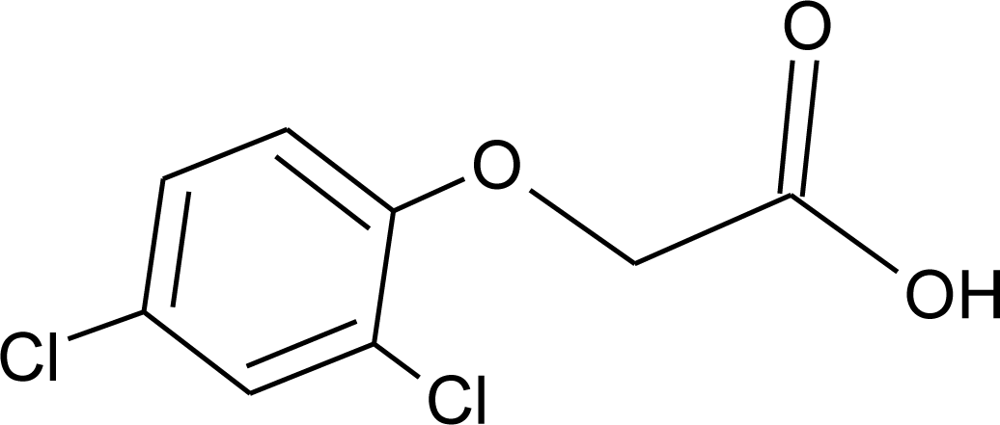 | Synergistic androgenic effects when combined with testosterone [67] | U: <LOD–598 ng/mL [68] S : 0.07–0.56 μg/g creatinine [69] |
| Acephate (I) M(g/Mol) = 183.2 pKa = 8.35 logP: −0.85 |  | Disruption of hormone expression in the hypothalamus [70] | U: <LOD–0.26 ng/mL [68] H.S: 7.2 μg/mL [71] ** |
| Acetochlor (H) M(g/Mol) = 269.8 pKa = n.a logP: 4.14 |  | Interaction with uterine estrogen receptors, alteration of thyroid hormone dependant gene expression [72,73] | U: <LOD–10.9 ng/mL [68] S: 0.08–0.10 μg/g creatinine [69] |
| Alachlor (H) M(g/Mol) = 269.8 pKa = 0.62 logP: 3.09 | 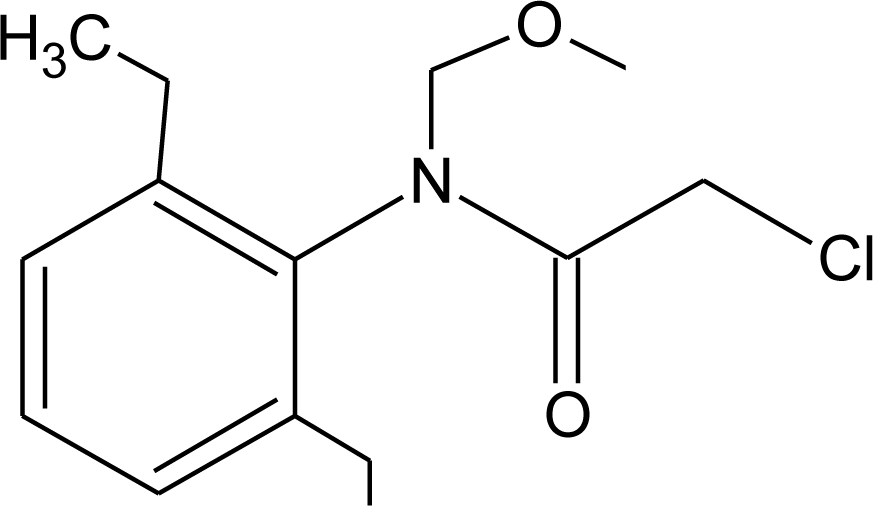 | Competitive binding to estrogen and progesterone receptors. Interaction with the pregnane X cellular receptor, interfering with the production of enzymes responsible for steroid hormone metabolism [13,74] | U: <LOD–305 ng/mL [68] S: 0.31–0.72 μg/g creatinine [69] |
| Aldicarb (I) M(g/Mol) = 190.3 pKa = n.a logP: 1.15 |  | Inhibition of 17 beta-estradiol and progesterone activity [13,75] | |
| Aldrin (I) M(g/Mol) = 364.9 pKa = n.a logP: 6.5 | 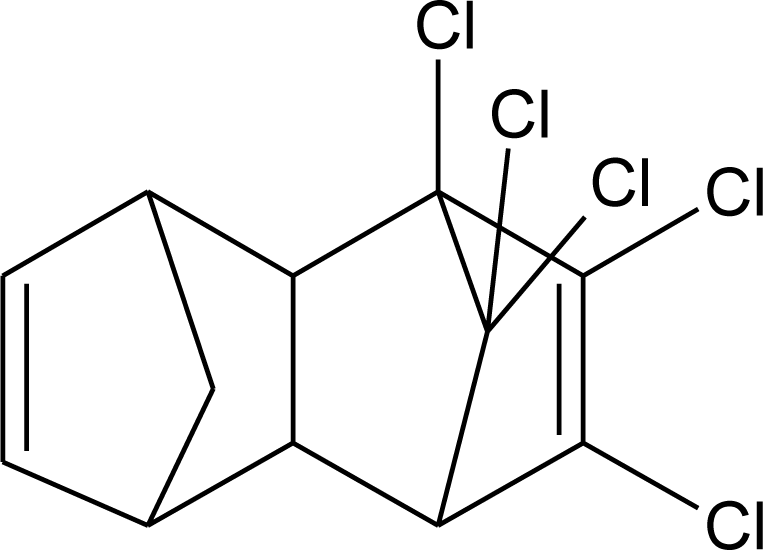 | Competitive binding to androgen receptors [76] | H.S: 2.17–372 μg/L [77,78] H.M: mean 0.03 mg/L ± 0.03 [79] A.T: 25.6–137.2 ng/g lipid [78] |
| Atrazine (H) M(g/Mol) = 215.7 PKa = 4.14, 10.7 logP: −0.97 | 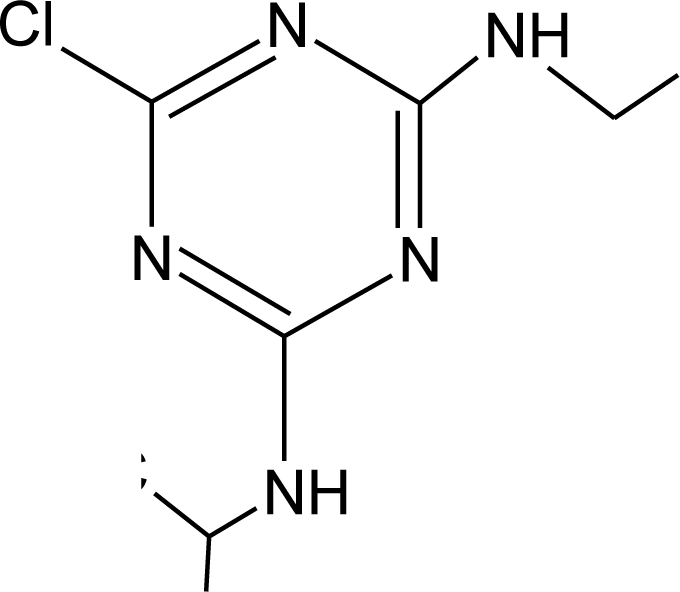 | Androgen inhibition, weak estrogenic effect. Disruption of the hypothalamic control of lutenising hormone and prolactin levels. Induction of aromatase activity, increase estrogen production. Adrenal glands damages and reduction of steroid hormone metabolism [13,80–83] | U: <LOD–9.2 ng/mL [68,84] H.S: mean 2 pg/g [76,85] S: 0.07–0.17 μg/g creatinine [69] |
| Bendiocarb (I) M(g/Mol) = 223.2 pKa = 8.8 logP: 1.7 | 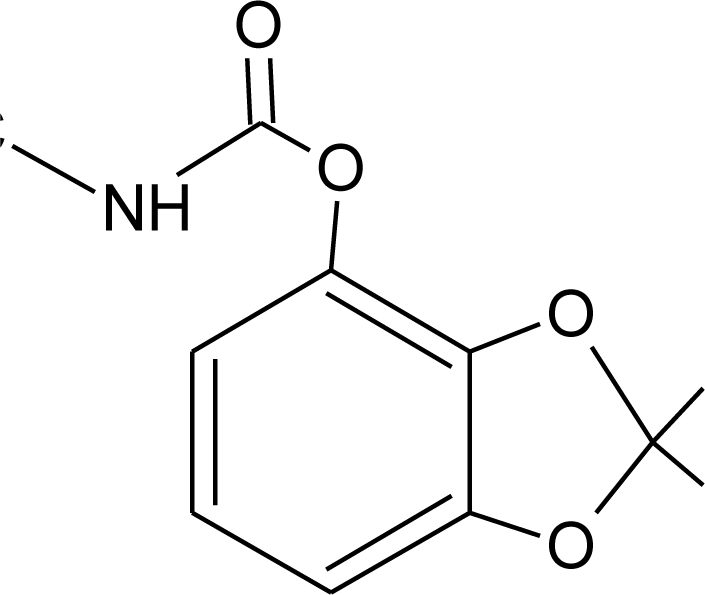 | Weak estrogen effect [13] | |
| Benomyl (F) M(g/Mol) = 290.3 pKa = 4.48 logP: 1.4 | 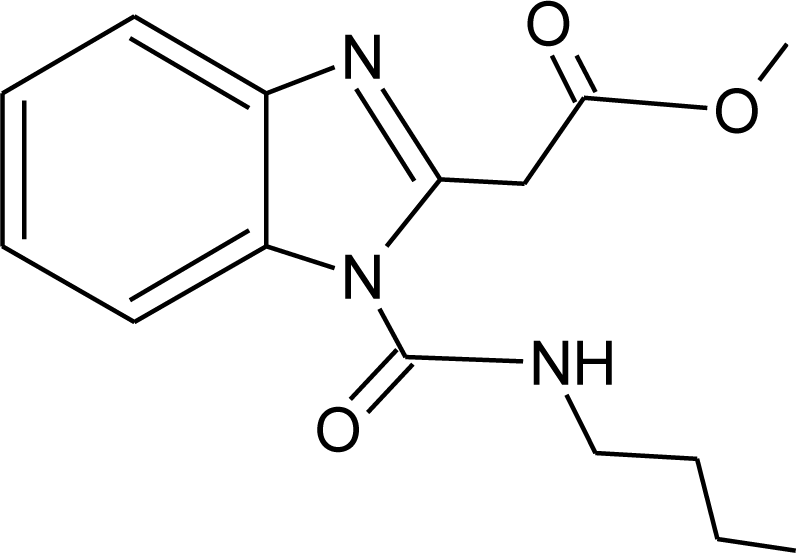 | Increase of estrogen production and aromatase activity [86] | |
| Bioallethrin (I) M(g/Mol) = 302.4 pKa = n.a logP: 4.68 |  | Inhibition of estrogen-sensitive cells proliferation [87] | M: 0.61–1.79 μg/mL [88] H: 1.08–2.74 μg/mL [88] |
| Bitertanol (F) M(g/Mol) = 337.4 pKa = n.a logP: 4.1 |  | Inhibition of aromatase activity, decrease of estrogens production and increase of androgens availability [89] | |
| Bupirimate (F) M(g/Mol) = 316.4 pKa = 4.4 logP: 3.68 | 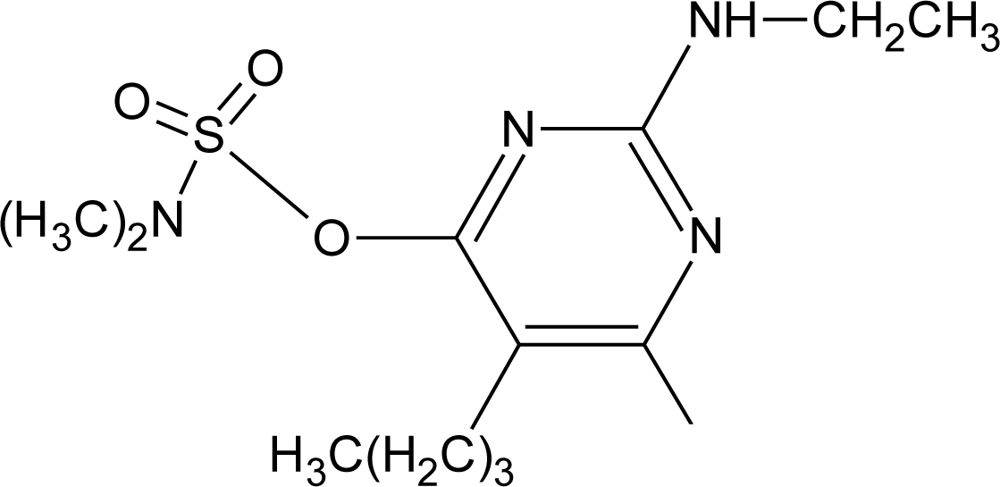 | Activation of Pregnane X cellular receptor [11] | |
| Captan (F) M(g/Mol) = 300.6 pKa = n.a logP: 2.5 | 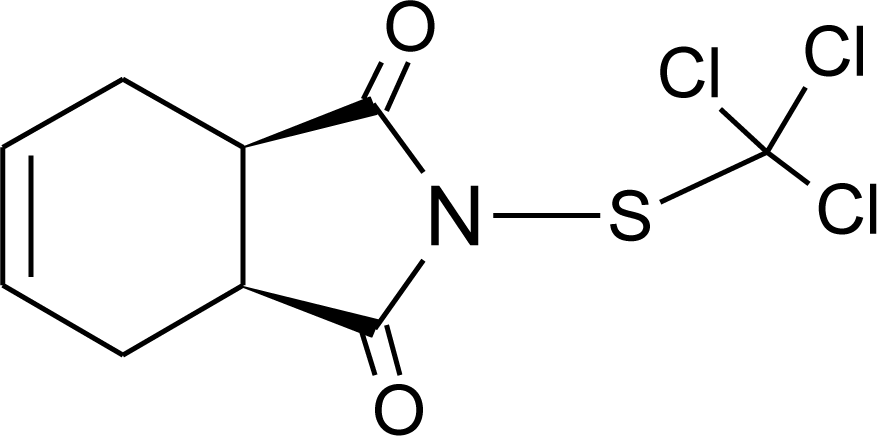 | Inhibition of estrogen action [90] | |
| Carbaryl (I) M(g/Mol) = 201.2 pKa = 10.4 logP: 2.36 | 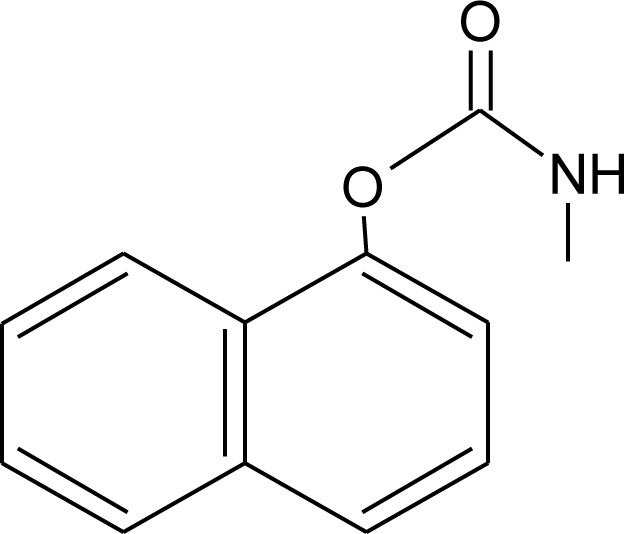 | Weak estrogen effect [13] | |
| Carbendazim (F) M(g/Mol) = 191.2 pKa = 4.2 logP: 1.48 |  | Increase of estrogen production and aromatase activity [86] | |
| Carbofuran (I) M(g/Mol) = 221.2 pKa = n.a logP: 1.8 |  | Increase of progesterone, cortisol and estradiol level and decrease of testosterone one [91] | M.S: 0.007–17.63 ng/g [92] U.C: 0.007–13.97 ng/g [92] |
| Chlorothalonil (F) M(g/Mol) = 265.9 pKa = n.a logP: 2.94 |  | Activation of androgen-sensitive cells proliferation [93] | M.S: 0.007–25.31 ng/g [92] U.C: 0.007–25.12 ng/g [92] H.S: mean 6 pg/g [85] |
| Chlordane (I) M(g/Mol) = 409.8 pKa = n.a logP: 2.78 | 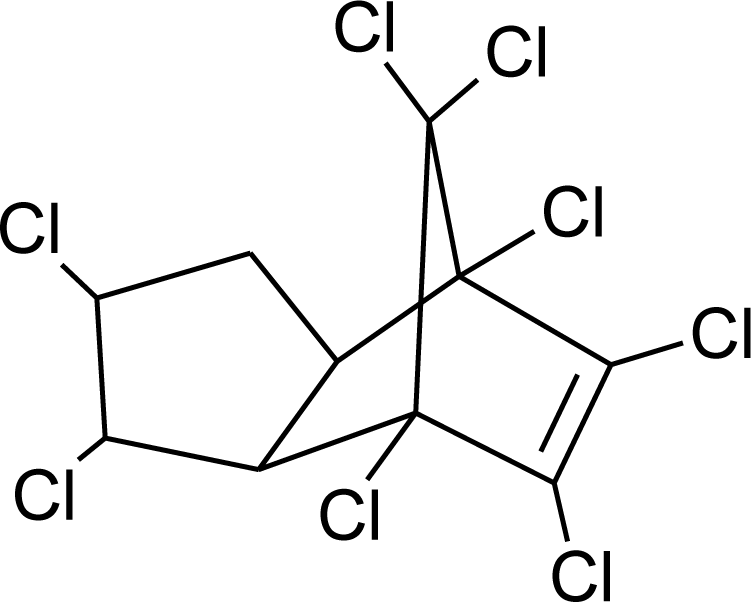 | Competitive binding to androgen receptors [76] Anti-estrogenic effect, inhibition of estradiol binding [13] | M.P: 0–2.7 ng/g lipid [94] B.S: <LOD–0.9 ng/g lipid [95] H.M: 0.02–437 ng/g lipid [79,96–99] FF: 0.1–0.3 ng/L [100] |
| Chlordecone (I) M(g/Mol) = 490.6 pKa = n.a logP: 4.5 |  | Binding to estrogen and androgen receptors [90,101,102] | |
| Chlorfenviphos (I) M(g/Mol) = 359.6 pKa = n.a logP: 1.36 | 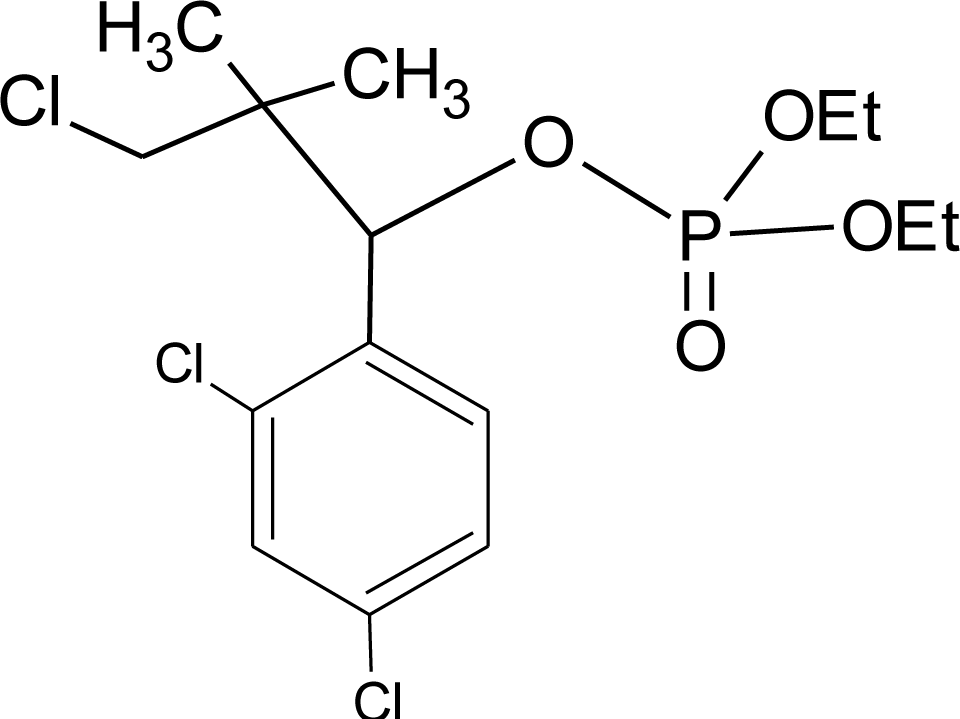 | Weak estrogen effect [103] | |
| Chlorpyrifos methyl (I) M(g/Mol) = 322.5 pKa = n.a logP: 4 |  | Antagonist to androgen activity [104] | U : <LOD–57.7 ng/mL* [68,84] M.S: 0.0007–10.1 ng/g [92] U.C: 0.0007–1.84 ng/g [92] H.S: mean 9 pg/g [85] H: 1.77–2.16 1.83 μg/mL [88] |
| Cypermethrin (I) M(g/Mol) = 416.3 pKa = n.a logP: 5.3 | 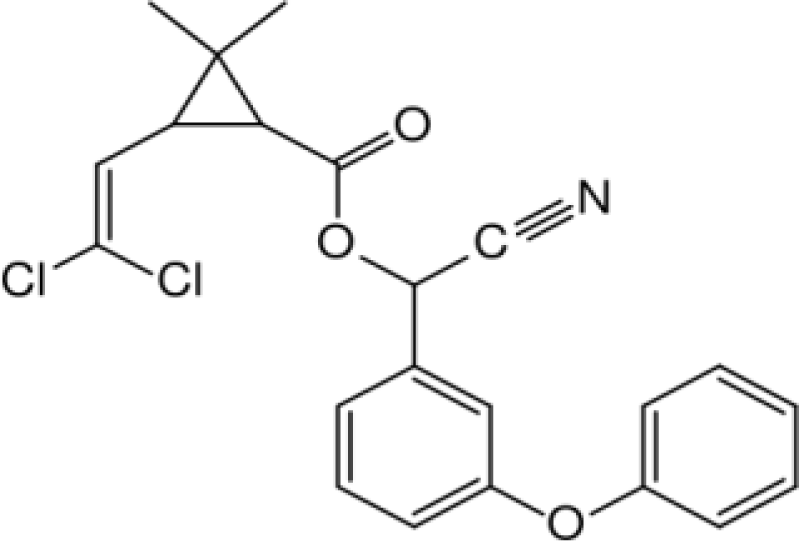 | Estrogenic effect [105,106] | U: 0.5–100.4 μg/g * [107] M: 1.85–2.43 μg/mL [88] |
| Cyproconazole (F) M(g/Mol) = 291.8 pKa = n.a logP:3.09 |  | Inhibition of aromatase activity, decrease of estrogens production and increase of androgens availability [89] | |
| DDT and metabolites (I) M(g/Mol) = 354.5 pKa = n.a logP:6.91 |  | Competitive binding to androgen receptors, activation of androgen-sensitive cells proliferation. Stimulation of estrogen receptor production, estrogen receptor agonist and PR antagonist [76,93,108,109] | M.P: 0.2–3588 ng/g lipid [94] B.S: <LOD–40.9 ng/g lipid [95] HM: 3.9–4700 ng/g lipid [110,96–99,111] A.F: 0.1–0.63 mg/L [112] M: 1.1–2.8 μg/mL [88] H: 0.17–0.65 μg/mL [88,113] M.B: 0–6168 ng/g lipid [110,114] H.S: 12.5–814.9 ng/mL [77] U.C: 189–3296 ng/g lipid [110] |
| Deltamethrin (I) M(g/Mol) = 505.2 pKa = n.a logP: 4.6 |  | Weak estrogenic activity [8] | U: 0.5–57.7 μg/g * [107] |
| Diazinon (I) M(g/Mol) = 304.4 pKa = 2.6 logP: 3.69 |  | Estrogenic effect [115] | S: 1.84–4.96 μg/g creatinine * [69] H.S: mean 2 pg/g [85] |
| Dichlorvos (I) M(g/Mol) = 221 pKa = n.a logP: 1.9 |  | Weak androgen-receptor antagonist [8] | |
| Dicofol (I) M(g/Mol) = 370.5 pKa = n.a logP: 4.3 | 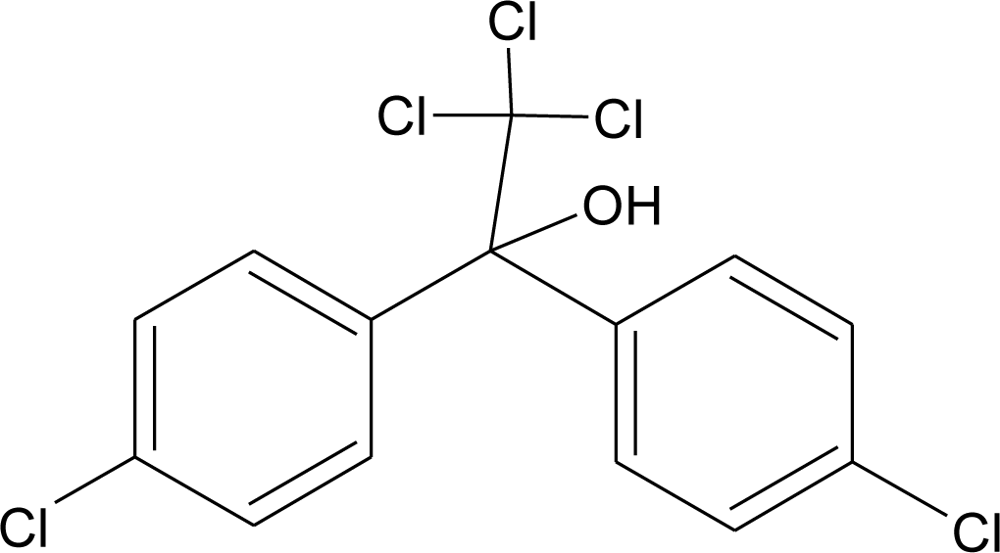 | Inhibition of androgen synthesis, increase of estrogens synthesis, binding to estrogen receptor [90,83] | |
| Dieldrin (I) M(g/Mol) = 380.9 pKa = n.a logP: 3.7 |  | Competitive binding to androgen receptors, estrogenic effect, stimulation of estrogen receptor production [8,76,108,116] | H.M: <0.1–64 ng/g lipid [111] |
| Diflubenzuron (I) M(g/Mol) = 310.7 pKa = n.a logP: 3.89 | 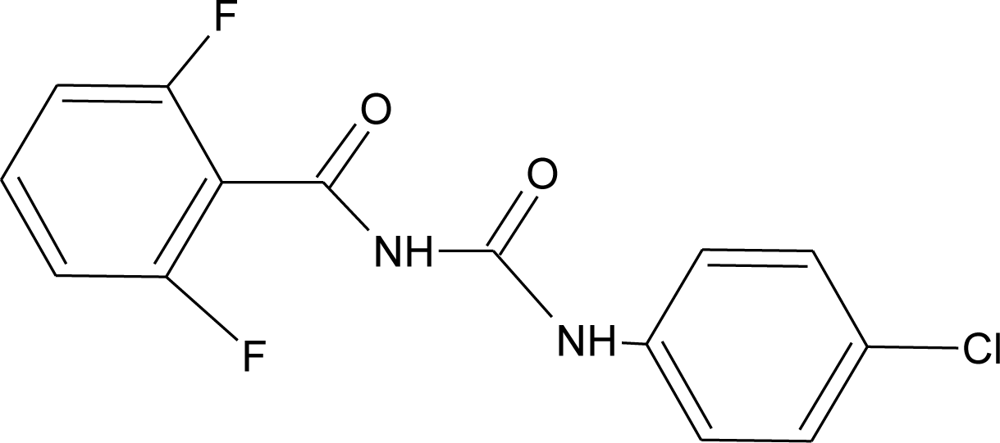 | Pregnane X cellular receptor activation [11] | H.S: 1.21–356.4 μg/L [77,78] H.M: mean 0.66 mg/L ± 1.75 [79] A.T: 17.01–84.05 [78] |
| Dimethoate (I) M(g/Mol) = 229.3 pKa = n.a logP: 0.704 |  | Disruption of thyroid hormones action. Increase of insulin blood concentration, decrease of luteinizing hormone blood concentration [117,118] | |
| Diuron (H) M(g/Mol) = 233.1 pKa = n.a logP: 2.87 | 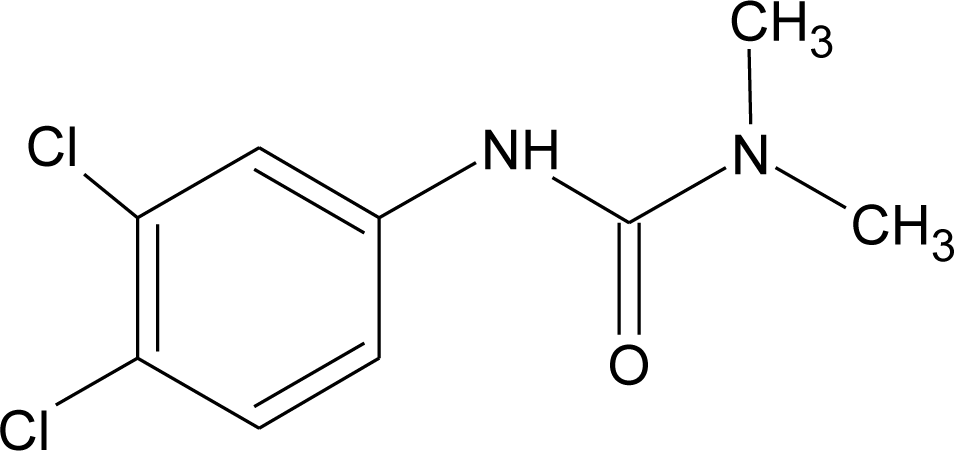 | Inhibition of androgens action [83] | |
| Endosulfan (I) M(g/Mol) = 406.9 pKa = n.a logP: 4.75 |  | Competitive binding to androgen receptors, estrogenic effect, stimulation of estrogen receptor production, inhibition of aromatase activity [8,76,109,116] | H.S: 8.85 547.6 μg/L [77,78] A.T: 21.4 417.6 ng/g lipid [78] |
| Endrin (I) M(g/Mol) = 380.9 pKa = n.a logP: 3.2 |  | Competitive binding to androgen receptors [76] | H.M: mean 0.65 mg/L ± 1.63 [79] H.S: 1.21 6.35 μg/L [78] A.T: 47.43 148.13 ng/g lipid [78] |
| Epoxyconazole (F) M(g/Mol) = 329.8 pKa = n.a logP: 3.3 |  | Inhibition of aromatase activity, decrease of estrogen production and increase available androgens [89,119] | |
| Fenarimol (F) M(g/Mol) = 331.2 pKa = n.a logP: 3.69 |  | Antagonist of androgenic action. Potential aromatase inhibition. Pregnane X cellular receptor activation [8,11,120] | |
| Fenbuconazole (F) M(g/Mol) = 336.8 pKa = n.a logP: 3.79 | 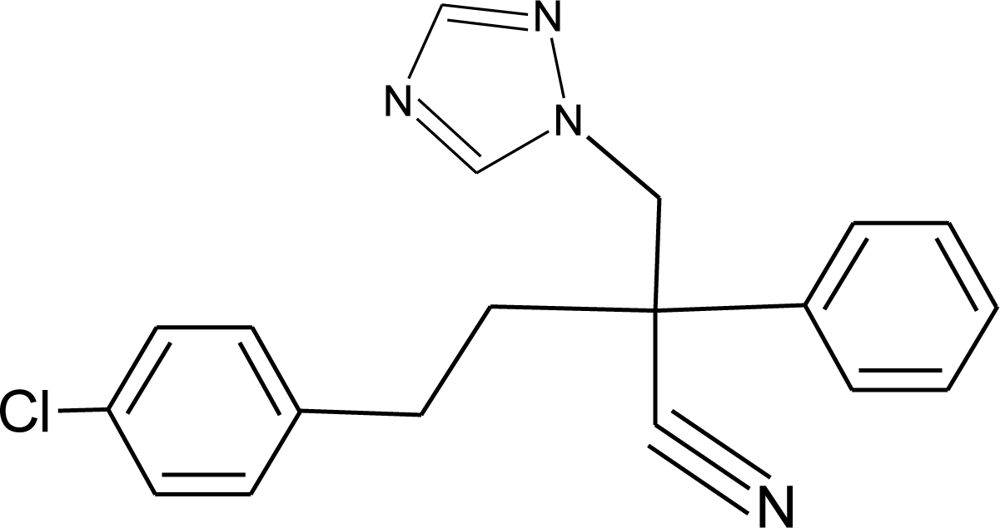 | Inhibition of thyroid hormones production, Pregnane X cellular receptor activation [11,13] | |
| Fenitrothion (I) M(g/Mol) = 277.2 pKa = n.a logP: 3.32 |  | Competitive binding to androgen receptor, inhibition of estrogens action [90,121] | H.S: 4.5 μg/mL [71] ** |
| Fenoxycarb (I) M(g/Mol) = 301.3 pKa = n.a logP: 4.07 |  | Interference with testosterone metabolism [122] | |
| Fenvalerate (I) M(g/Mol) = 419.9 pKa = n.a logP: 5.01 |  | Inhibition of estrogen-sensitive cells proliferation, antagonist of the progesterone action [86,123] | |
| Fluvalinate (I) M(g/Mol) = 502.9 pKa = n.a logP: 3.85 | 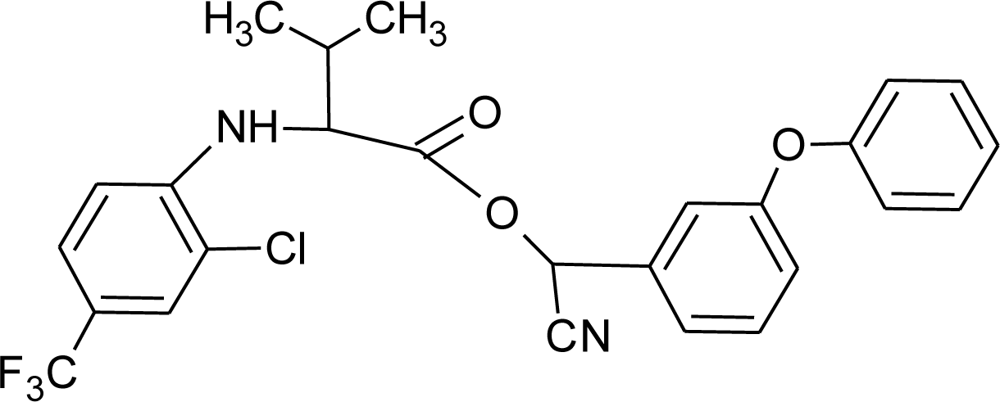 | Binding to human sex hormone, Inhibition of progesterone production [124,125] | |
| Flusilazole (F) M(g/Mol) = 315.4 pKa = 2.5 logP: 3.87 | 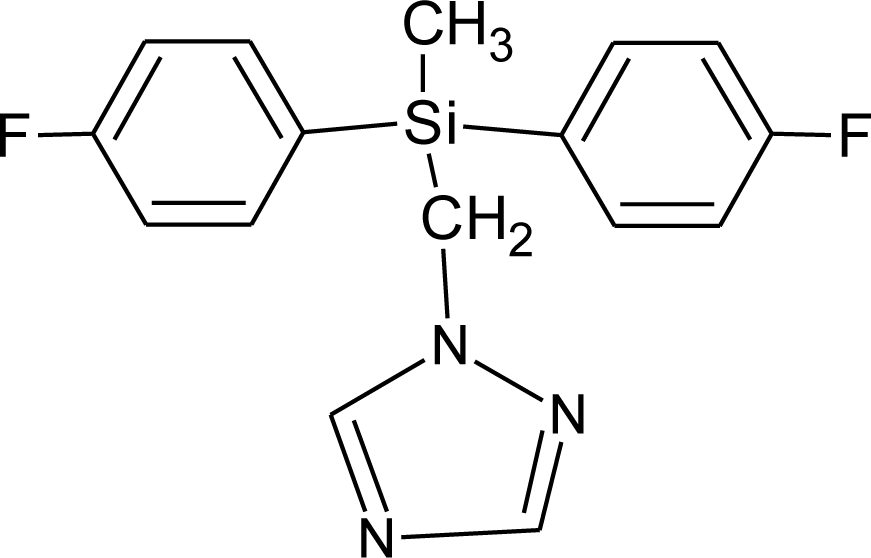 | Inhibition of aromatase activity, decrease of estrogens production, increase of available androgens [89] | |
| Flutriafol (F) M(g/Mol) = 301.3 pKa = 2.3 logP: 2.3 | 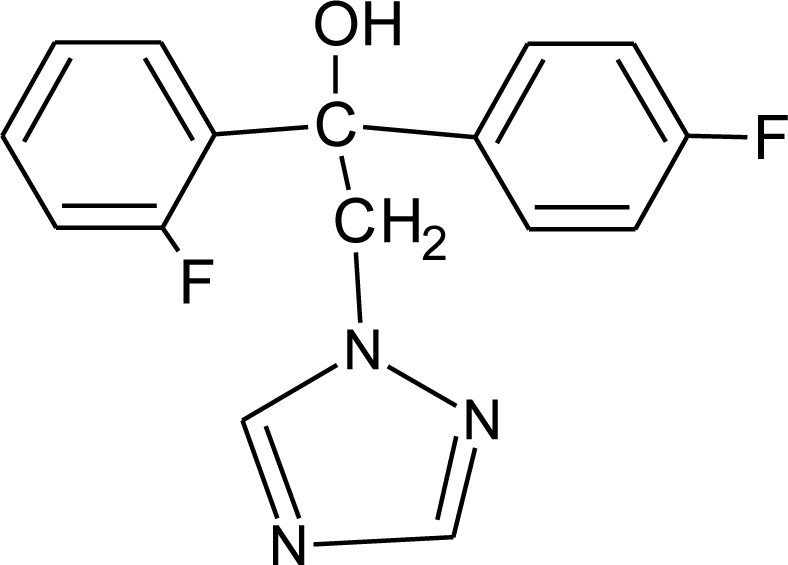 | Weak estrogen inhibition [119] | |
| Glyphosphate (H) M(g/Mol) = 168.1 pKa = 0.78; 2.34; 5.96; 10.98 logP: −3.2 |  | Disruption of aromatase activity, preventing the production of estrogens [126] | U: 1.1–2.1 ng/mL [84] |
| HCB (F) M(g/Mol) = 284.8 pKa = n.a logP: 3.93 | 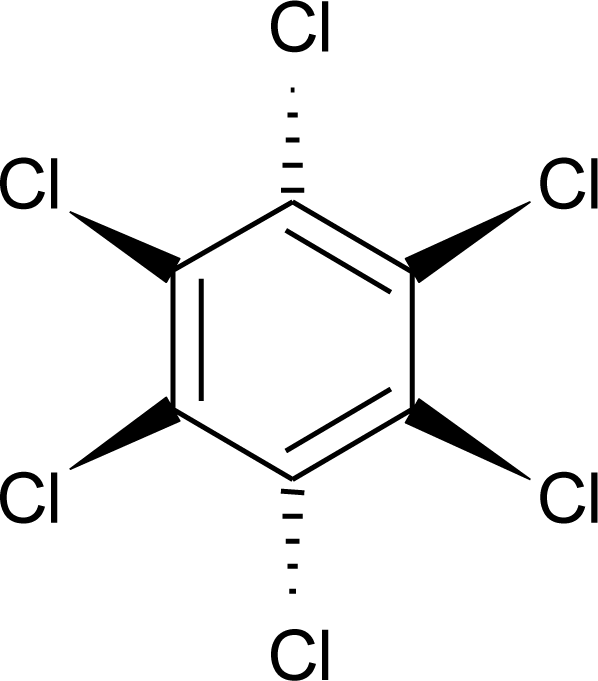 | Severely disruption of thyroid hormone production. Enhancement of androgen action at low doses, but inhibition at high levels [127,128] | M.P: 1.6–44.3 ng/g lipid [94] B.S: 7.4–37.2 ng/g lipid [95] H.M: 0.4–472 ng/g lipid [79,96–99] H.S: 12.5–393.3 μg/L [77] H 1.2–15.9 pg/mg [113] F.F: 0.11–0.2 ng/L [100] A.F: [112] |
| HCH (lindane) (I) M(g/Mol) = 290.8 pKa = n.a logP: 3.61 | 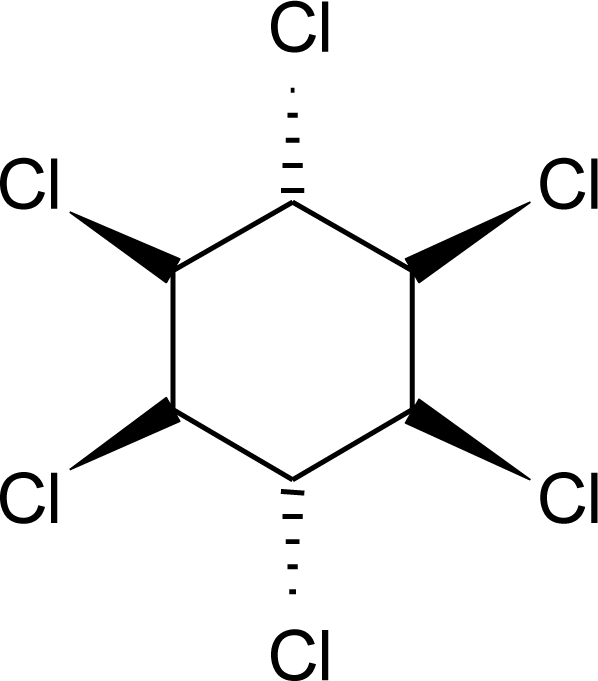 | Reduction of oestrous cycles and luteal progesterone concentrations. Increase of insulin and estradiol blood serum concentrations, decrease thyroxine concentrations. Competitive binding to AR, ER and PR [117,129] | M.P: 0.4–2839 ng/g lipid [94] B.S: <LOD–134 ng/g lipid [95] H.M: 4.7–8700 ng/g lipid [80,110,96–99] H.S: 1.08–265.8 μg/L [77,78] H: 50.7–235 pg/mg [113] A.T: 17.44–113.31 ng/g lipid [78] M.B: 1.9–386.6 ng/g lipid [110, 114] A.F: 0.1–0.26 ng/mL [112] U.C: 4–130 ng/g lipid [110] |
| Heptachlor (I) M(g/Mol) = 373.3 pKa = n.a logP: 5.44 | 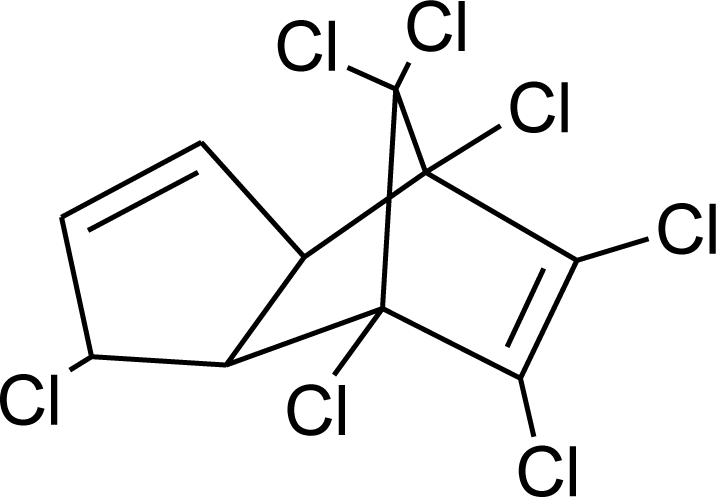 | Binding to cellular estrogen and androgen receptors [130,131] | M.P: 0.2–5.2 ng/g lipid [94] B.S: <LOD–0.9 ng/g lipid [95] Human serum: 12.5–139.1 μg/L [77] H.M: mean 0.07 mg/L ± 0.34 [79] |
| Hexaconazole (F) M(g/Mol) = 314.2 pKa = 2.3 logP: 3.9 | 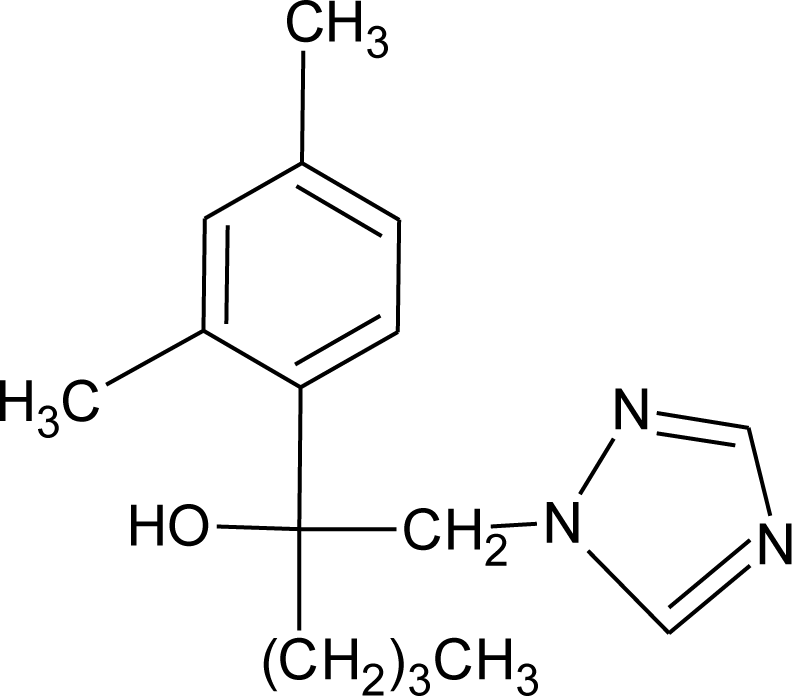 | Inhibition of aromatase activity, decrease of the estrogens production and increase of available androgens [89] | |
| Isoproturon (H) M(g/Mol) = 206.3 pKa = n.a logP: 2.5 | 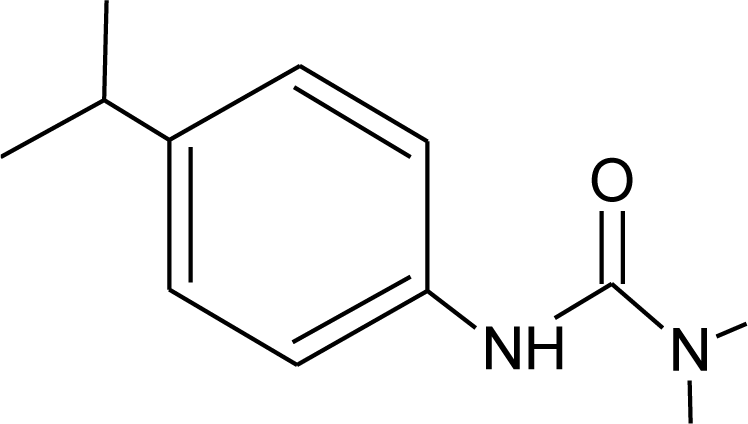 | Pregnane X cellular receptor activation [11] | |
| Iprodione (F) M(g/Mol) = 330.2 pKa = n.a logP: 3.1 | 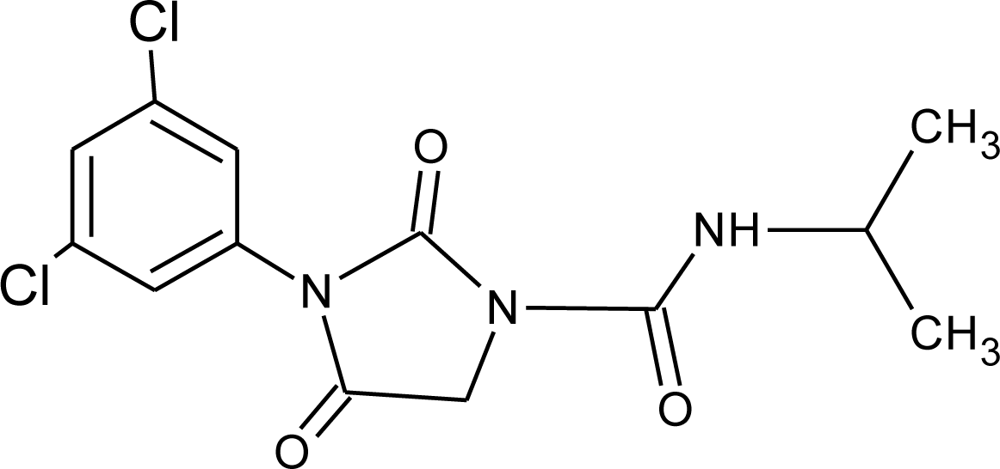 | Increase weakly aromatase activity, and estrogen production [8] | |
| Linuron (H) M(g/Mol) = 249.1 pKa = n.a logP: 3 | 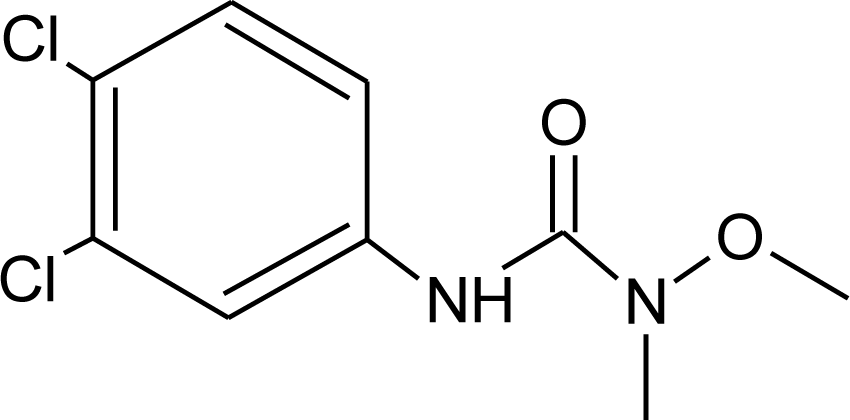 | Competitive binding to androgen receptor, thyroid receptor agonist [131,132] | |
| Malathion (I) M(g/Mol) = 330.4 pKa = n.a logP: 2.75 | 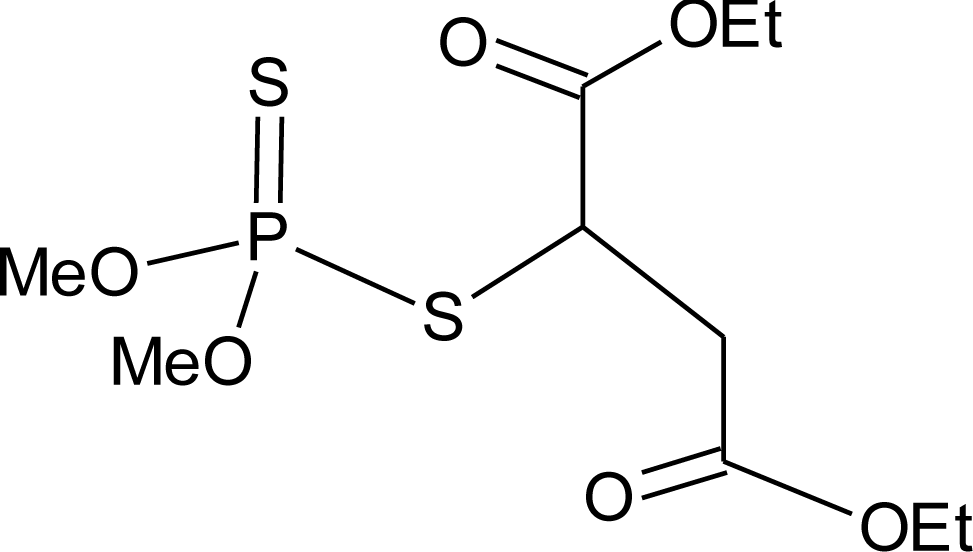 | Inhibition of catecholamine secretion, binding to thyroid hormone receptors [13,133] | U: <LOD–3195 ng/mL [68] * M: 2.92–5.38 μg/mL [88] H: 1.62–2.12 μg/mL [88] S: 0.37–0.92 μg/g creatinine [69] |
| Methiocarb (H) M(g/Mol) = 225.3 pKa = n.a logP: 3.18 | 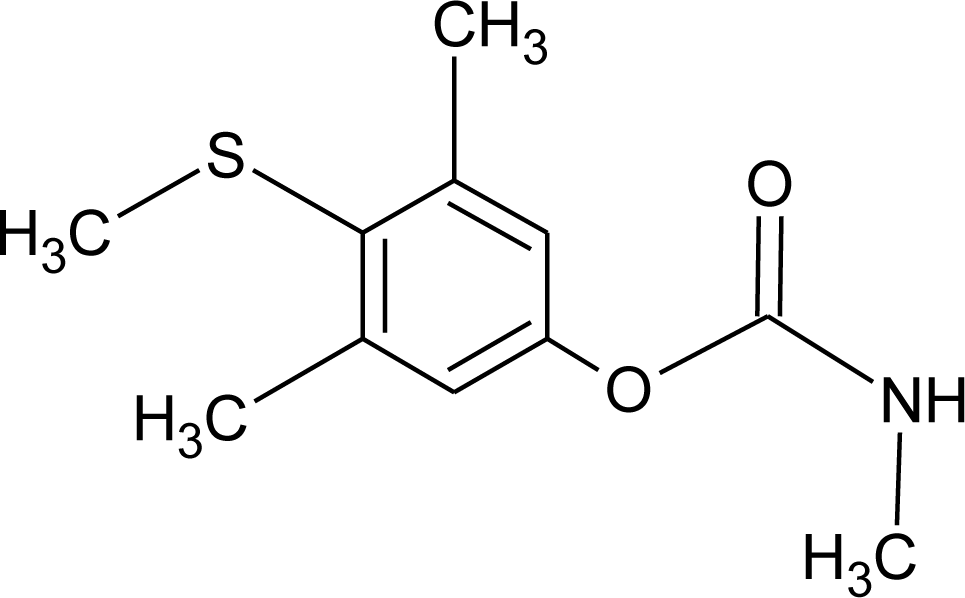 | Inhibition of androgen activity and increase of estrogen one [8] | |
| Methomyl (I) M(g/Mol) = 162.2 pKa = n.a logP: 1.24 |  | Weak increase of aromatase activity and estrogen production [8,13] | |
| Methoxychlor (I) M(g/Mol) = 345.7 pKa = n.a logP: 5.83 |  | Strong estrogenic effect. Competitive binding to androgen receptor, interaction with the pregnane X cellular receptor [13,74,76] | H.S: 0.38–0.39 μg/L [78] A.T: 29.86–155.58 ng/g lipid [78] |
| Metolachlor M(g/Mol) = 283.8 pKa = n.a logP: 3.4 |  | Pregnane X cellular receptor activation [11] | U: <LOD–4.5 ng/mL [68,84] H.S: mean 2 pg/g [85] M.S: 0.007–1.96 ng/g [92] U.C: 0.007–2.37 ng/g [92] S: 0.20–0.48 μg/g creatinine [69] |
| Metribuzin (H) M(g/Mol) = 214.3 pKa = 0.99 logP: 1.65 | 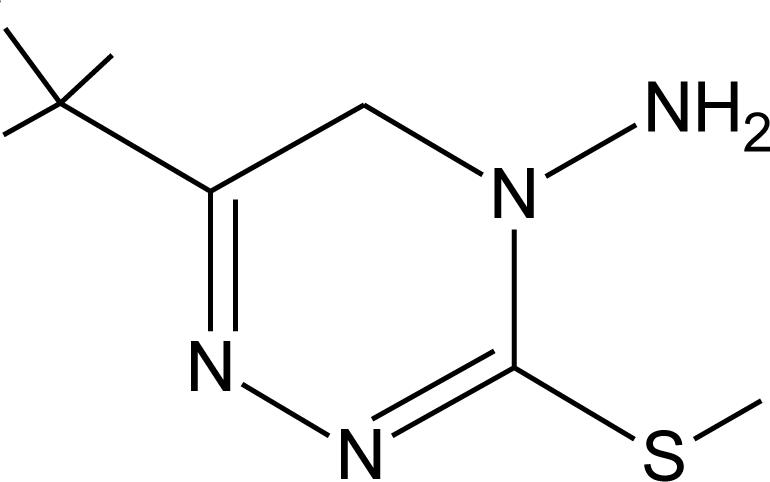 | Hyperthyroidism, alteration of somatotropin levels [134] | |
| Mirex (I) M(g/Mol) = 545.5 pKa = n.a logP: 5.28 |  | Weak estrogen effect [13] | M.P: 0.2–1.5 ng/g lipid [94] B.S: <LOD–7.2 ng/g lipid [95] H.M: 0.2–1.7 ng/g lipid [98] |
| Molinate (H) M(g/Mol) = 187.3 pKa = n.a logP: 2.86 | 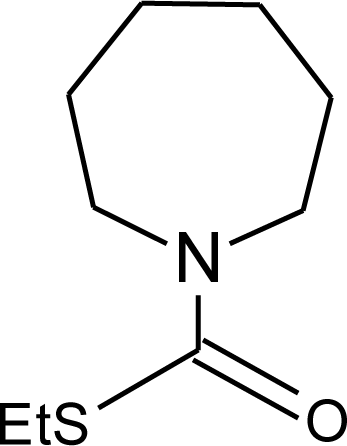 | Reproductive tract damage, reduction of fertility [13] | |
| Myclobutanil (F) M(g/Mol) = 288.8 pKa = 2.3 logP: 2.89 | 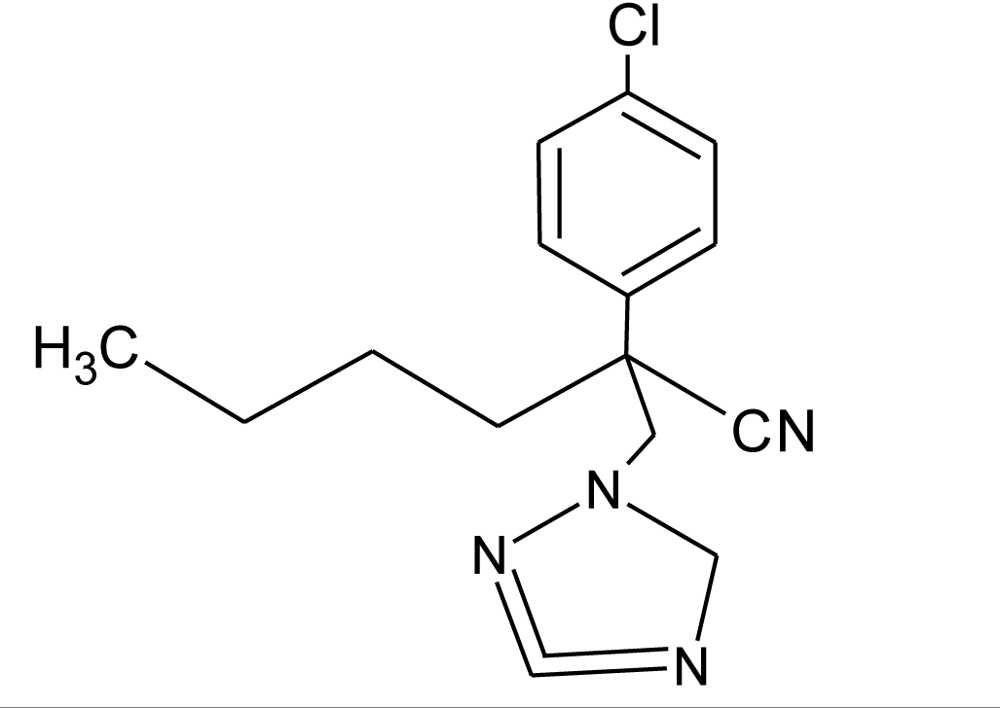 | Weak estrogen and androgen inhibition, Binding to estrogen and androgen receptors, aromatase inhibition [89,90,119] | |
| Nitrofen (H) M(g/Mol) = 284.1 pKa = n.a logP: 3.4 |  | Estrogen and androgen inhibition [90] | |
| Oxamyl (I) M(g/Mol) = 219.3 pKa = n.a logP: −0.44 |  | Weak estrogen effect [13] | |
| Parathion (I) M(g/Mol) = 291.3 pKa = n.a logP: 3.83 | 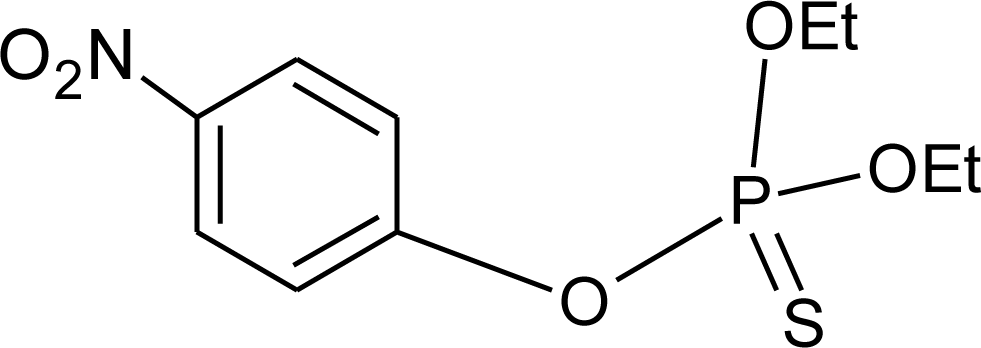 | Inhibition of catecholamine secretion, increase of melatonin synthesis, inhibition of gonadotrophic hormone [13] | U: <LOD–84 ng/mL * [68] |
| Penconazole (F) M(g/Mol) = 284.2 pKa = 1.51 logP: 3.72 | 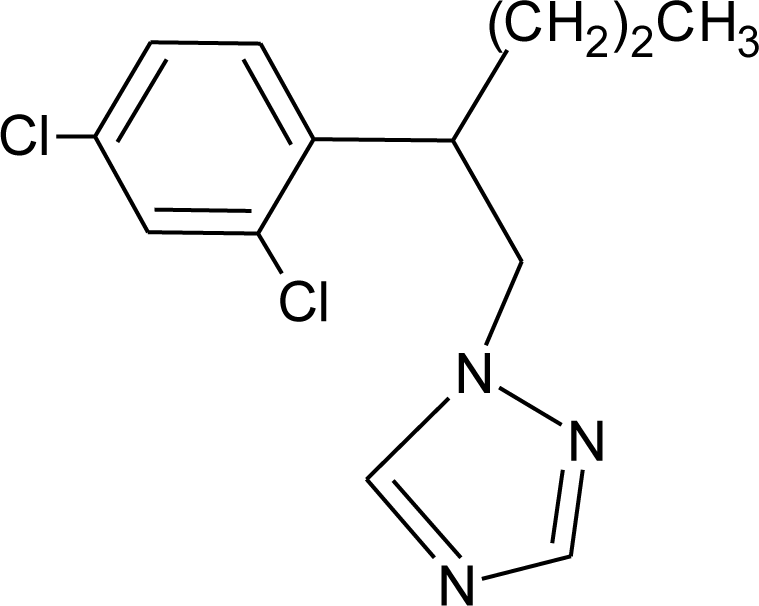 | Weak estrogenic effect. Inhibition of aromatase activity, decrease of estrogens production and increase androgens availability [89,119] | |
| Pentachlorophenol (H, F, I) M(g/Mol) = 266.3 pKa = 4.73 logP: 3.32 |  | Weak estrogenic and anti-androgenic affect [13] | A.F : 0.15–0.54 ng/mL [135] |
| Permethrin (I) M(g/Mol) = 391.3 pKa = n.a logP: 6.1 | 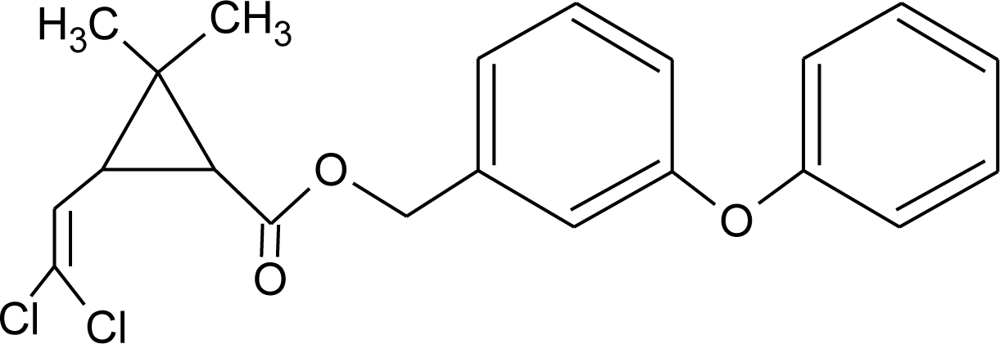 | Inhibition of estrogen-sensitive cells proliferation [87,106] | U: 1–150 μg/g * [107] |
| Phenylphenol (F) M(g/Mol) = 170.2 pKa = 9.97 logP:3.09 |  | Estrogen agonist [136] | A.F: 0.1–0.17 ng/mL [135] |
| Prochloraz (F) M(g/Mol) = 376.7 pKa = 3.8 logP: 3.53 | 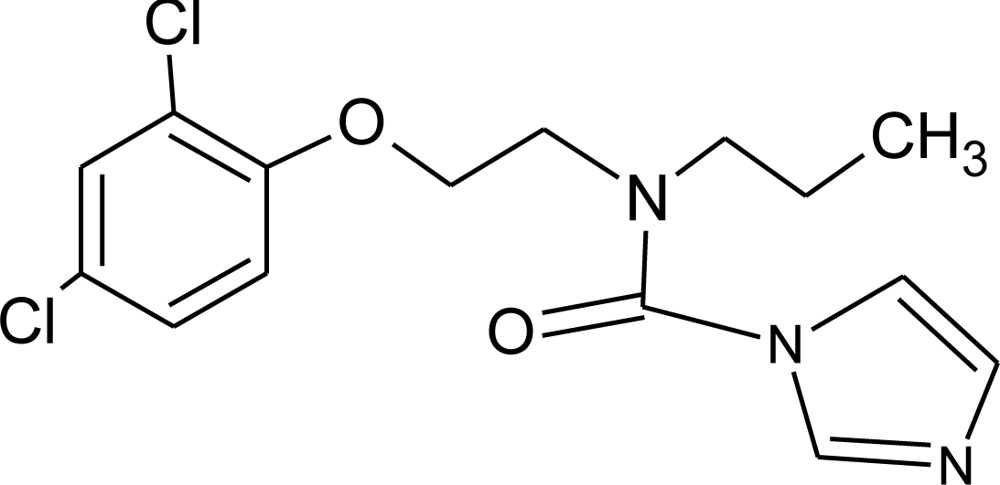 | Activation of Pregnane X cellular receptor. Antagonist to cellular androgen and estrogen receptors, agonist to Ah receptor and inhibition of aromatase activity [8,11,120,137] | |
| Procymidone (F) M(g/Mol) = 284.1 pKa = n.a logP: 3.3 |  | Competitive binding to androgen receptor [131] | |
| Propamocarb (F) M(g/Mol) = 188.3 pKa = 9.5 logP: 0.84 |  | Weak increase of aromatase activity and estrogen production [8] | |
| Propanil (H) M(g/Mol) = 318.1 pKa = n.a logP: 2.29 |  | Increase of cellular response to estrogen [138] | |
| Propazine (H) M(g/Mol) = 229.8 pKa = 1.7 logP: 3.95 | 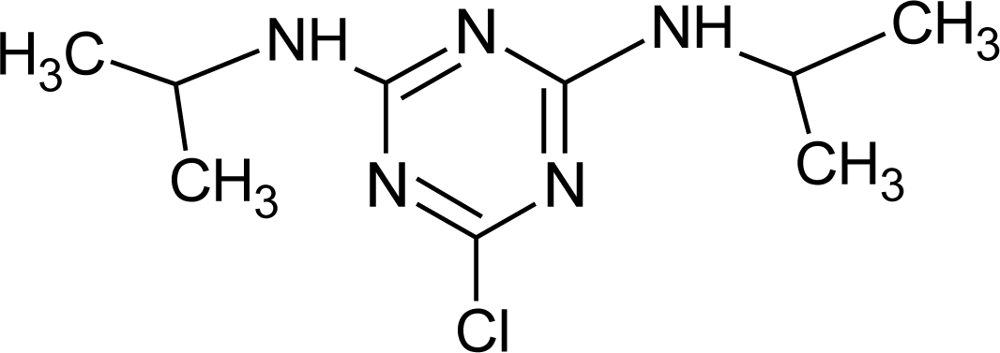 | Induction of aromatase activity and increase of estrogen production [81] | |
| Propiconazole (F) M(g/Mol) = 342.2 pKa = 1.09 logP: 3.72 |  | Weak estrogen and aromatase activity inhibition. Decrease estrogens production and increase of androgens availability [89,119] | |
| Propoxur (I) M(g/Mol) = 209.2 pKa = n.a logP: 0.14 |  | Weak estrogenic effect [13] | M: 0.24–1.50 μg/mL [88] C.B: 0.77 μg/mL [88] H: 0.22–0.42 μg/mL [88] M.B: 0.67–0.77 μg/mL [88] |
| Prothiophos (I) M(g/Mol) = 345.3 pKa = n.a logP: 5.67 |  | Estrogenic effect [115] | |
| Pyridate (H) M(g/Mol) = 378.9 pKa = n.a logP: 0.5 | 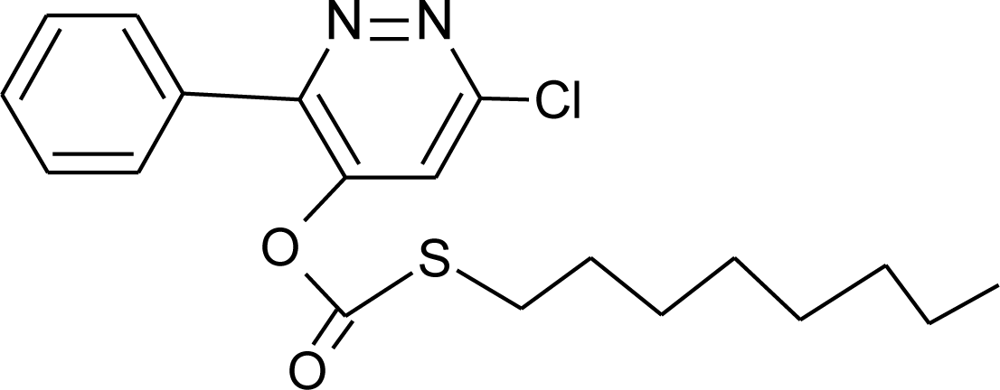 | Binding to estrogen and androgen receptors [90] | |
| Pyrifenox (F) M(g/Mol) = 295.2 pKa = 4.61 logP: 3.4 |  | Weak estrogen inhibition [119] | |
| Pyripyroxifen (I) M(g/Mol) = 321.4 pKa = 6.87 logP: 5.37 |  | Estrogenic effect [115] | |
| Resmethrin (I) M(g/Mol) = 338.4 pKa = n.a logP: 5.43 | 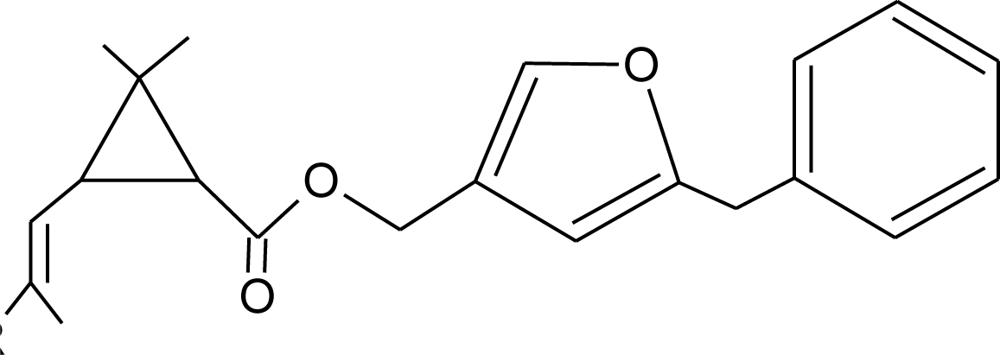 | Binding to sex hormone [124] | |
| Simazine (H) M(g/Mol) = 201.7 pKa = 1.62 logP: 2.3 |  | Induction of aromatase activity, increase of estrogen production [81] | |
| Sumithrin (I) M(g/Mol) = 350.5 pKa = n.a logP: 6.01 |  | Increase of estrogen-sensitive cells proliferation, antagonist of the progesterone action [87,123] | |
| Tebuconazole (F) M(g/Mol) = 307.8 pKa = n.a logP: 3.7 |  | Inhibition of aromatase activity, decrease the estrogens production and increase androgens availability [89] | |
| Tetramethrin (I) M(g/Mol) = 331.4 pKa = n.a logP: 4.6 | 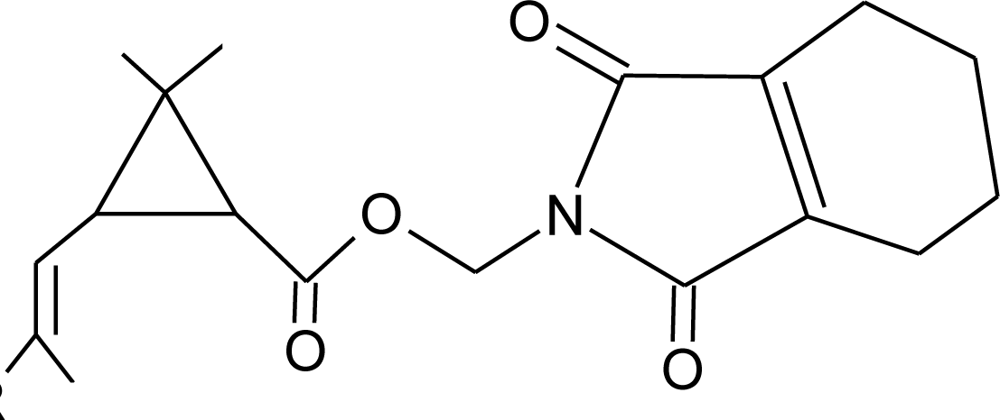 | Estrogen-antagonistic effects in females only [139] | |
| Tolchlofos-methyl (I) M(g/Mol) = 301.1 pKa = n.a logP: 4.56 | 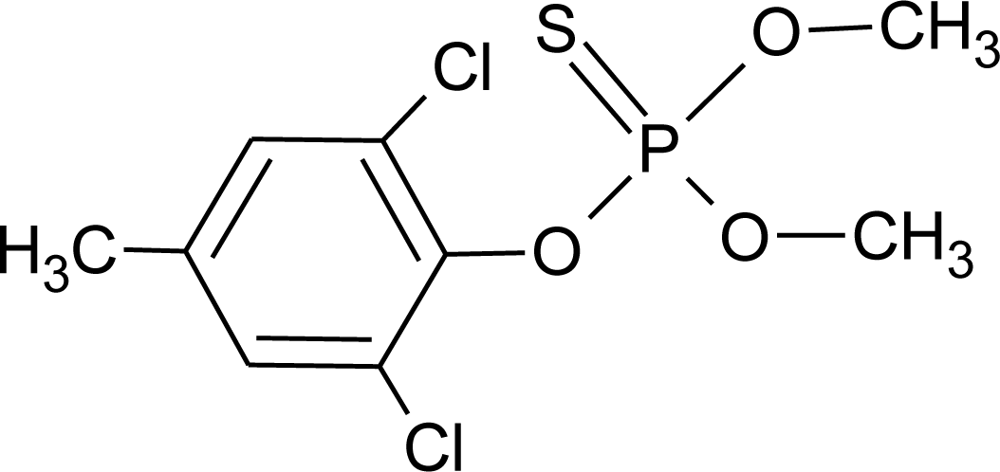 | Competitive binding to cellular estrogen receptors [120] | |
| Toxaphene (I) M(g/Mol) = 411.8 pKa = n.a logP: 3.3 | 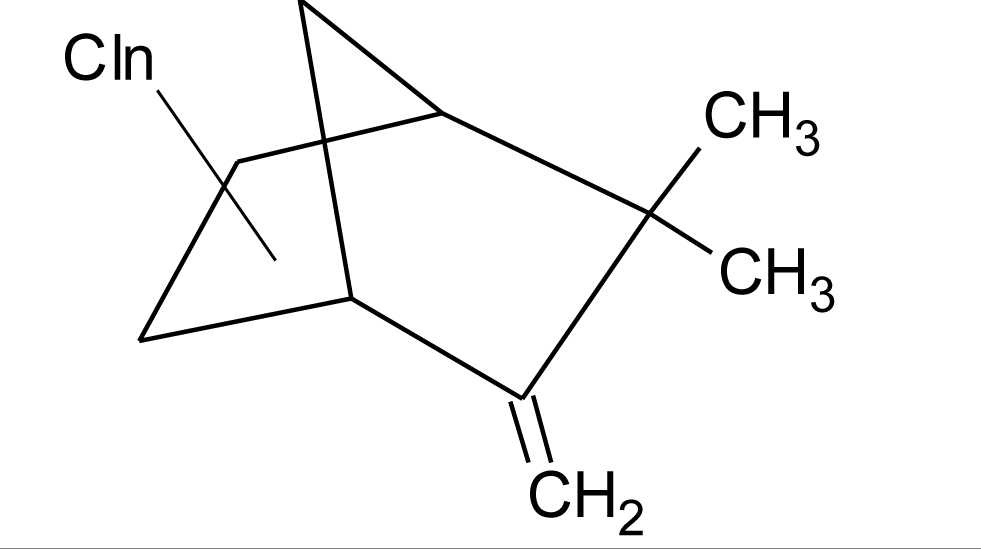 | Increase of estrogen-sensitive cells proliferation. Inhibition of corticosterone synthesis in the adrenal cortex [13,116] | |
| Triadimefon (F) M(g/Mol) = 293.8 pKa = n.a logP: 3.18 | 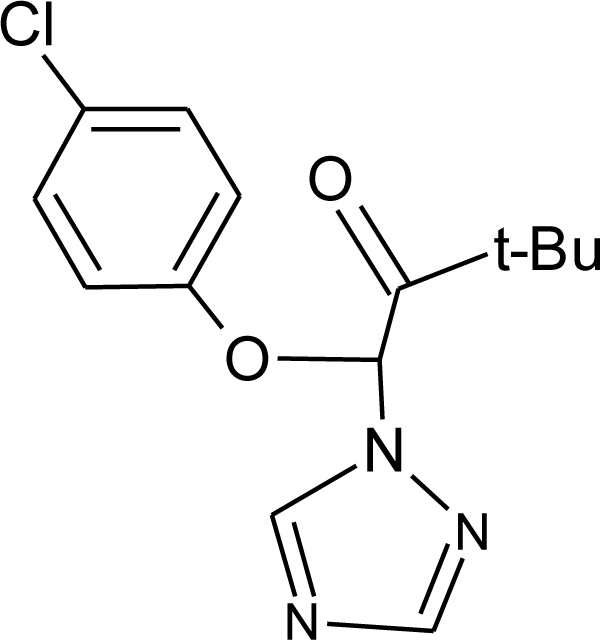 | Estrogenic effect, inhibition of aromatase activity, decrease of estrogens production and increase androgens availability [90] | |
| Triadimenol (F) M(g/Mol) = 295.8 pKa = n.a logP: 3.18 |  | Estrogenic effect, inhibition of aromatase activity, decrease of estrogens production and increase androgens availability [89,90] | |
| Tribenuron-methyl (H) M(g/Mol) = 395.4 pKa = 4.7 logP: 0.78 | 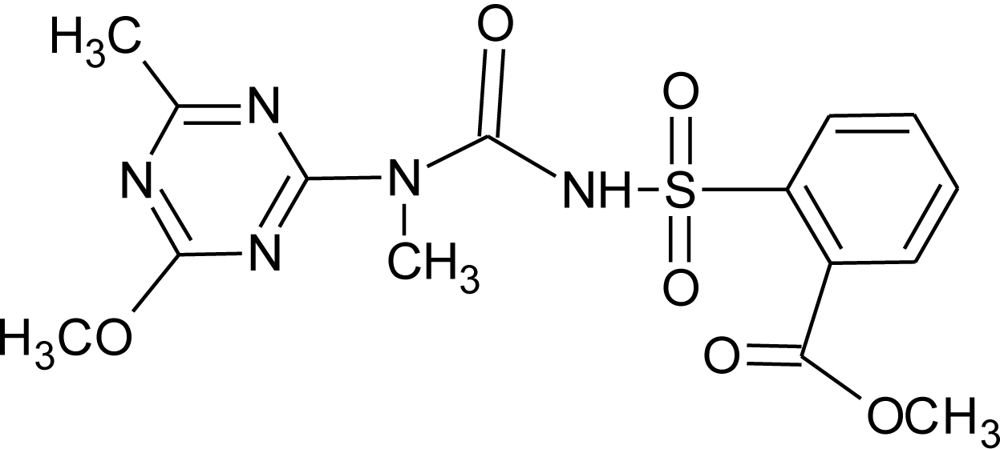 | Weak estrogenic effect [8] | |
| Trichlorfon (I) M(g/Mol) = 257.4 pKa = n.a logP: 0.43 | 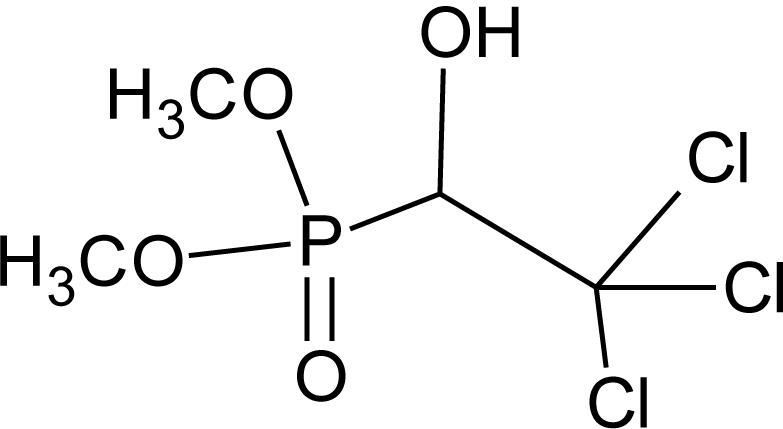 | Alteration of thyroid function [140] | |
| Trifluralin (H) M(g/Mol) = 335.3 pKa = n.a logP: 5.27 | 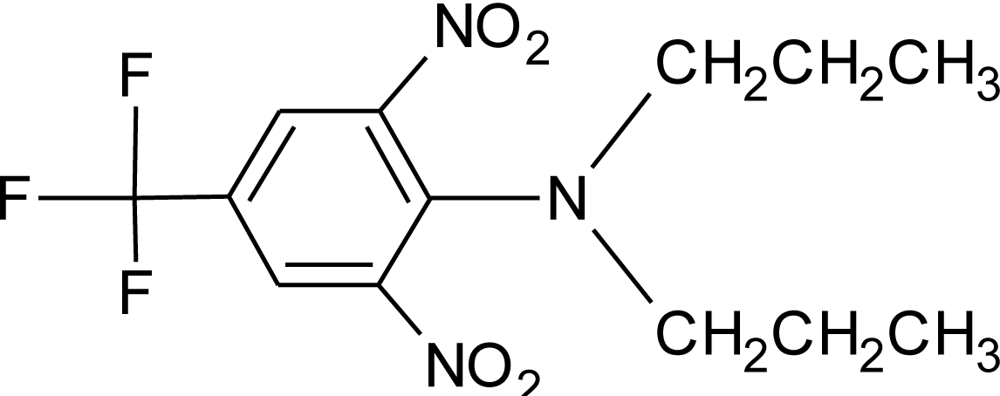 | Interaction withs pregnane X cellular receptor, interference steroid hormone metabolism [74] | M.S: 0.00–8.5 ng/g [92] U.C: 0.007–4.42 ng/g [92] |
| Vinclozolin (F) M(g/Mol) = 286.1 pKa = n.a logP: 3.02 |  | Competitive binding to androgen receptor Interactions with pregnane X cellular receptor, interference with steroid hormone metabolism. [8,74,131] |
© 2011 by the authors; licensee MDPI, Basel, Switzerland. This article is an open-access article distributed under the terms and conditions of the Creative Commons Attribution license (http://creativecommons.org/licenses/by/3.0/).
Share and Cite
Mnif, W.; Hassine, A.I.H.; Bouaziz, A.; Bartegi, A.; Thomas, O.; Roig, B. Effect of Endocrine Disruptor Pesticides: A Review. Int. J. Environ. Res. Public Health 2011, 8, 2265-2303. https://doi.org/10.3390/ijerph8062265
Mnif W, Hassine AIH, Bouaziz A, Bartegi A, Thomas O, Roig B. Effect of Endocrine Disruptor Pesticides: A Review. International Journal of Environmental Research and Public Health. 2011; 8(6):2265-2303. https://doi.org/10.3390/ijerph8062265
Chicago/Turabian StyleMnif, Wissem, Aziza Ibn Hadj Hassine, Aicha Bouaziz, Aghleb Bartegi, Olivier Thomas, and Benoit Roig. 2011. "Effect of Endocrine Disruptor Pesticides: A Review" International Journal of Environmental Research and Public Health 8, no. 6: 2265-2303. https://doi.org/10.3390/ijerph8062265
APA StyleMnif, W., Hassine, A. I. H., Bouaziz, A., Bartegi, A., Thomas, O., & Roig, B. (2011). Effect of Endocrine Disruptor Pesticides: A Review. International Journal of Environmental Research and Public Health, 8(6), 2265-2303. https://doi.org/10.3390/ijerph8062265




